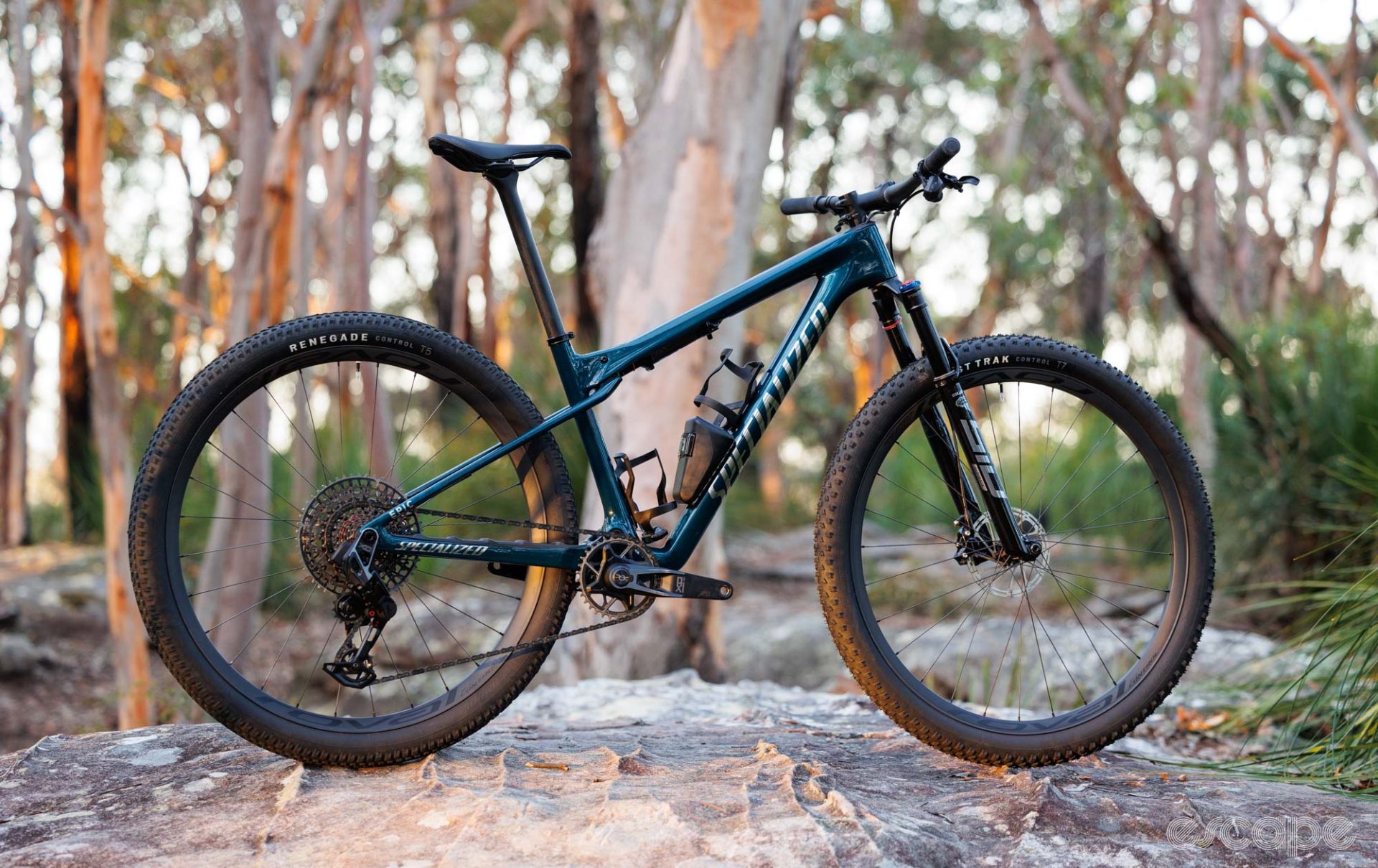The sport of cross-country mountain bike racing has gone through some significant changes in recent years. A push to make professional racing more exciting for those at home has made races shorter and courses more technical with high-risk features. In turn, we often see races being won on trail-like bikes with 120 mm of travel front and rear, while hardtails are so rarely picked they kickstart conversations about boring course design when dusted off.
Further playing a role in bike design is a UCI rule that requires pro athletes to use the same bike between the Short Track (XCC) and Cross Country Olympic (XCO) races over a single World Cup weekend. The hardtail may be best for some short track races, but it’s rarely the fastest choice on modern XCO tracks. Instead, most riders pick the bike for the main event and make do in the short track by locking out the rear suspension, or in rare cases, swapping out the rear shock for a rigid strut.
And that gets us to the Specialized Epic WC (World Cup). It’s intended to be a full-suspension bike that pedals like it isn’t one. With the American company believing full suspension is always the faster choice for the discipline, the Epic WC boldly supersedes the top-tier Epic hardtail, and so, like how Trek did with its latest Supercaliber, Specialized is now done with premium hardtails.
Both James Huang and I have tested this intriguing new model for a number of months, and my procrastination in writing this review is telling of the uncertainty that ensued. This detailed review questions what a modern cross-country bike should and shouldn’t do, and raises doubt about whether more efficient-feeling suspension truly is more efficient.
- The short of it: In believing that full suspension is always the faster choice in mountain biking, the Epic WC is Specialized’s replacement for its top-tier cross-country race hardtails.
- Good stuff: Can be set to pedal like a hardtail, is incredibly efficient on smooth surfaces, dialled geometry, lovely frame build quality, good frame rigidity with no creaks or groans, no fiddly remote lockouts means an ultra-clean cockpit, solid component spec choices with nice wheels and a powermeter.
- Bad stuff: Suspension can either feel choppy or have you wishing for a lockout, poor headset sealing, minimal weight advantage over a longer-travel full suspension, Brain-equipped fork still has a thunk, no dropper provided, SRAM Level brake lever feel and power.
An Epic intro
Since its release in 2003, the Specialized Epic has remained one of the most competitive and best-selling full-suspension cross-country bikes globally. For two decades, the full suspension Epic was based around the use of Specialized’s “Brain” damper technology, which automatically (and hands-free) kept the rear suspension locked out like a hardtail until a large enough force from the rear wheel would open the shock’s damper to absorb impacts.
With each iteration, the Epic’s mass-based Brain got progressively better at opening the damper for small bump absorption, and they made it more reliable, and lighter, too. However Specialized was never quite able to make it a wholly seamless ride experience, and even the most recent iteration had a subtle thunk and edge to it as the suspension damper opened. At the same time, the Brain-equipped Epic was light, but in seeking to replace its hardtail, the company wanted it even lighter.
By contrast, just about every other brand making cross-country bikes achieves such pedalling efficiency through either suspension kinematics, manual lockouts, or commonly a combination of both. Specialized offers bikes that do just this, such as the current longer-travel Epic Evo. Meanwhile, for the Epic WC, the goal was to retain the hands-free hardtail-like pedalling performance that the Brain technology offered but make it even more efficient against pedalling forces, make it lighter, and make it simpler.
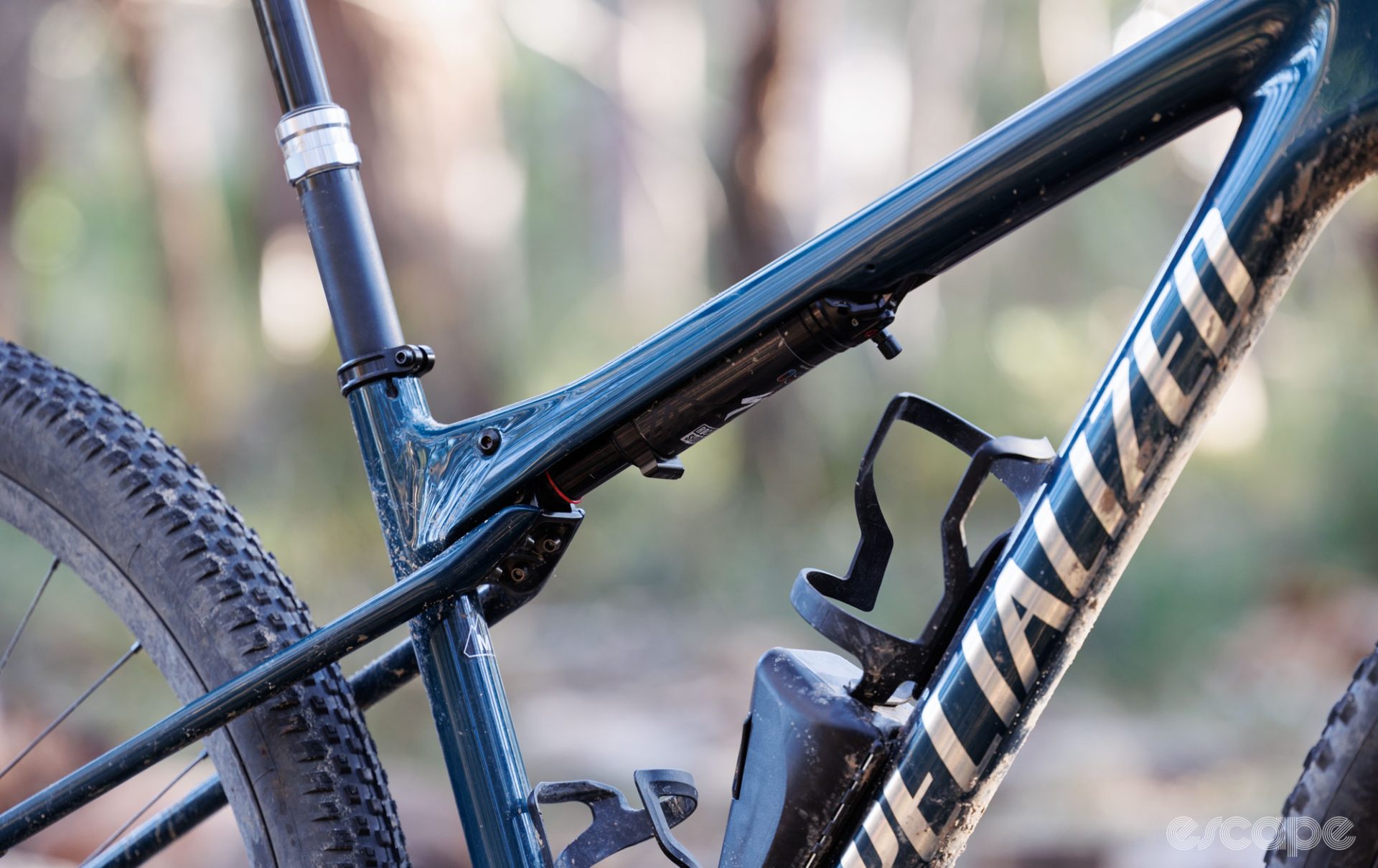
The new Epic WC still features the Brain technology in the fork, but its rear suspension ditches the Brain in favour of less-suspension travel and a simpler approach. Where the Brain automatically controlled whether the damping circuit was open or closed (locked), Specialized’s new RockShox SID “World Cup Integrated Design’ (WCID) rear suspension instead relies on the air spring to provide a similarly firm (or rock-solid) pedalling platform to the reduced 75 mm of rear travel. Meanwhile, the front wheel is boosted in suspension travel, now at 110 mm.
Specialized has gone all-in on using the air spring for pedalling efficiency. There is no manual lockout to flick. Heck, even the low-speed compression and rebound adjustments require the use of a hex wrench. As a result, it’s up to the user to set the air pressure for between 0-10% sag to best match the terrain before the start gun sounds. By contrast, with 80 mm of rear wheel travel, the similar-looking Trek Supercaliber was first on the path of wanting to kill off the hardtail, but its approach remains different by running more traditional levels of sag and allowing its racer to control that movement with a remote lockout.
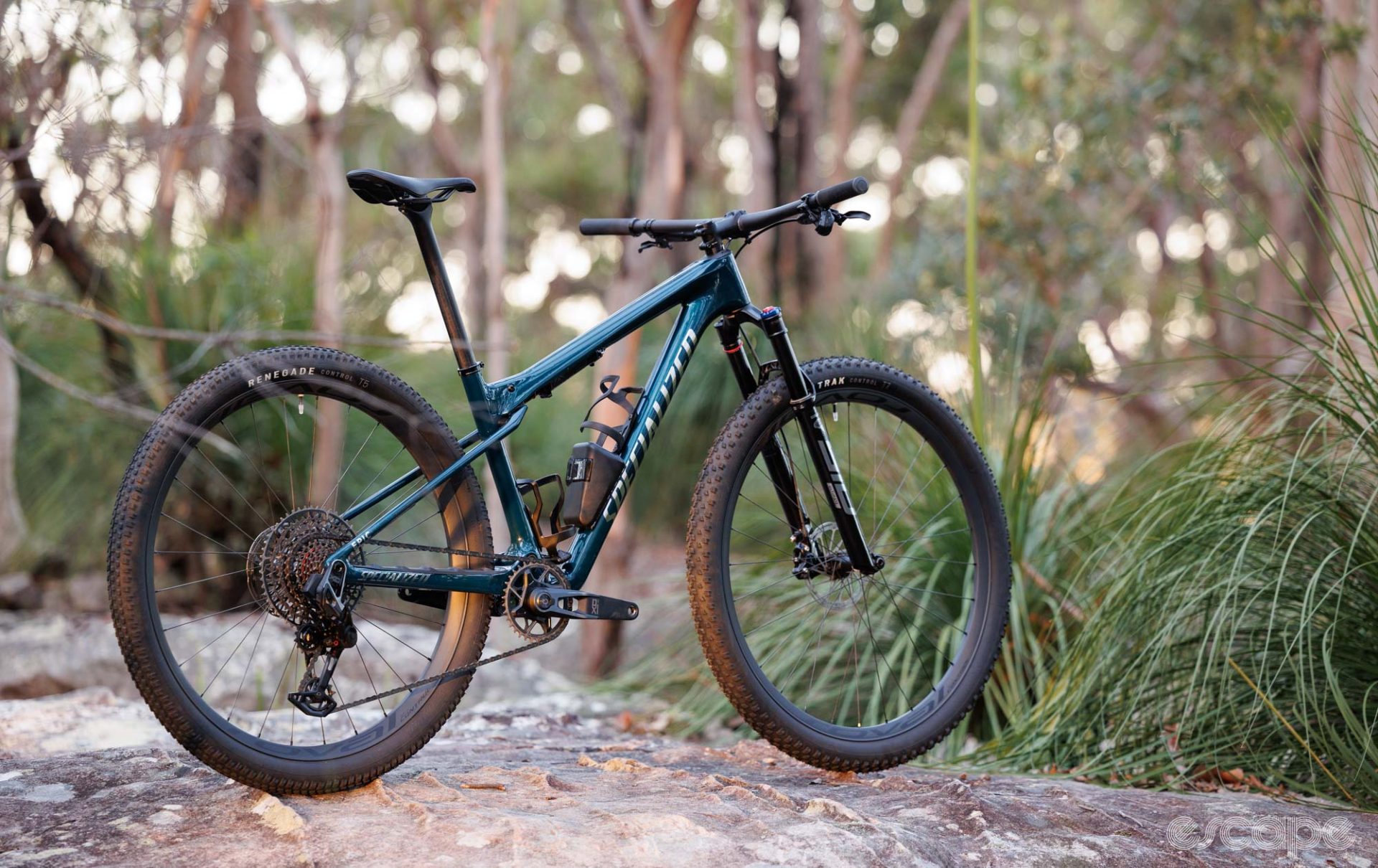
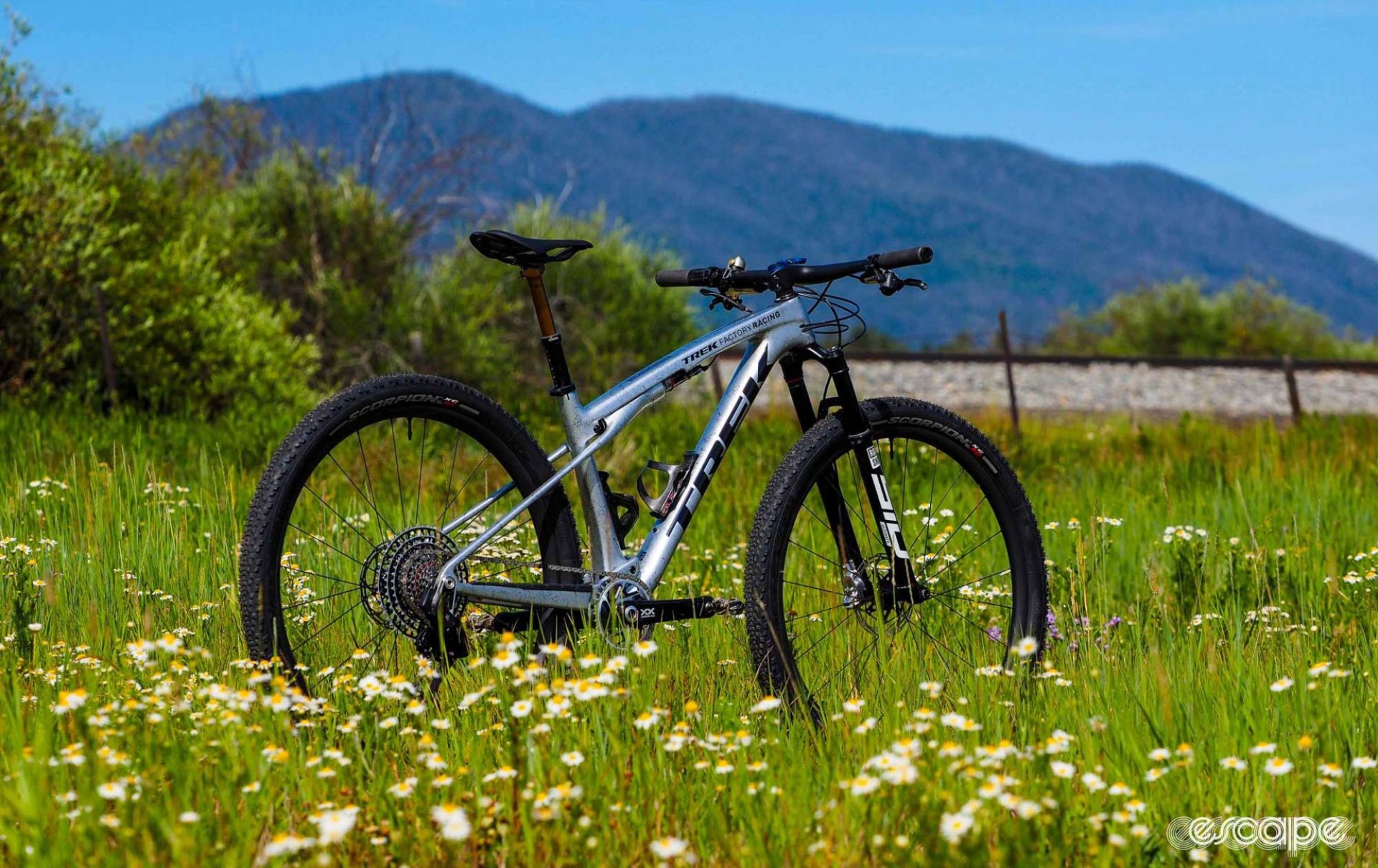
Specialized places its unique shock into a half-moon-shaped top tube with open access to the shock. Where Trek’s strut-type design integrates the rear shock into the seatstay of the bike, Specialized’s layout is far more traditional. The rear of the shock is merely bolted to a mini swing link, and that’s driven with a flex stay pivot suspension layout similar to most other new cross-country race bikes on the circuit.
Lighter? Sort of.
It may look and pedal like a hardtail, but one of the last remaining benefits of a hardtail is the figure on the scale, and it’s here that the Epic WC story gets tricky. A medium-size and painted Epic WC frame in an eye-wateringly-expensive S-Works version is claimed to weigh 1,765 grams, including the 292 g WCID shock and rear thru-axle. As I tested, the Epic WC Pro frame, with its marginally lower grade of carbon fibre layup, is claimed to weigh 1,865 grams with shock.
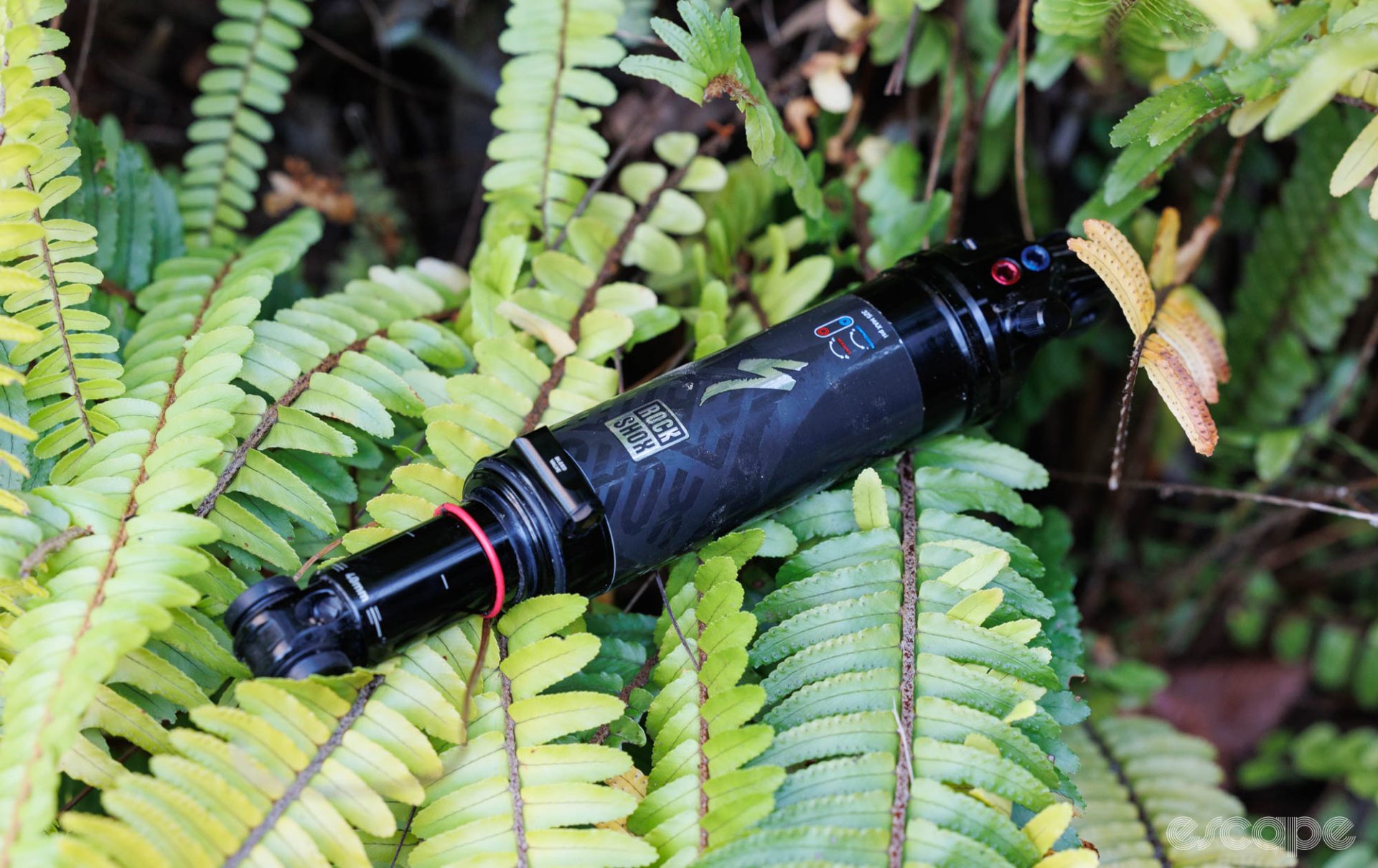
That S-Works Epic WC is one of the lightest full suspension frames on the market and saves about 100 grams over the previous Brain-equipped Epic frame, but it’s actually heavier than Specialized’s own longer travel S-Works Epic Evo at 1,712 g. You’ll also find that other longer-travel frames such as the Orbea Oiz OMX and Scott Spark HMX SL are competitive in weight at 1,798 and 1,870 grams, respectively. And remember, this is comparing the Epic WC with its 75 mm of travel to frames with 100 to 120 mm of travel. For reference, the similar-looking Trek Supercaliber SLR frame with its 80 mm of rear travel sits at a claimed 1,950 grams.
Specialized suggests that once built into a bike, its Epic WC will be lighter than any other full suspension – including the Epic Evo – when accounting for the weight of remote lockouts. It’s a claim that seems to hold true, with James’ medium-sized S-Works tester weighing an impressive 9.36 kg (20.6 lbs) without pedals or any accessories. This is certainly a light figure for a full suspension bike, but it’s worth noting that it doesn’t include a dropper post.
Meanwhile, in a medium size, the Epic WC Pro tested weighs 10.3 kg (22.7 lbs) without pedals, and was 10.49 kg (23.1 lbs) when including the Specialized bottle cages, SWAT multi-tool, and SWAT XC Box (empty). Fully kitted out with a RockShox AXS Reverb dropper, XTR pedals, SWAT box contents, and a computer mount, the bike weighed a not-so-hardtail-like 11.5 kg (25.3 lb).
And then we get to actual hardtails. Specialized is phasing out the S-Works-level Epic hardtail from its range, a frame that carries an impressive weight of just 820 g with hardware. Meanwhile, the likes of Cannondale, Canyon, Focus, and Scott all offer frames within 80 grams of such a paltry figure. So a top-tier Epic WC with its 75 mm of rear travel adds just shy of a kilogram (2.2 lbs) to an equivalent-level hardtail.
Features and geometry
The suspension is the biggest part of the Epic WC’s story, but a few new frame features are also worth discussing. Specialized hides a patented steering stopper within the headset, a feature that not only saves the top tube from being smashed by your levers, but also surely helps to prevent the now headset-routed cables from being kinked within. It’s neatly done and I don’t wholly hate it, but I’ll return to its issues.

The Epic was the first mainstream full-suspension platform to offer room for two water bottles within the main triangle, and the new WC only improves on such clearance. This feature is easily taken for granted, but it’s worth emphasizing how important and useful it is for marathon and/or stage-race racing. These days if an XC-focussed bike doesn’t have room for two bottles within the main triangle, it’s off my shortlist.
The now-simpler rear shock is proprietary to the frame (like the Epic has always been), but thankfully the rest of the frame offers plenty of welcomed open compatibility. There’s a regular 73 mm English threaded bottom bracket, a 30.9 mm seatpost (with dropper routing) held with an external clamp, a UDH derailleur hanger (needed for SRAM Transmission compatibility), and common Boost wheel spacing. There’s room to fit up to 29 x 2.4″ tyres in the rear end. And the bike also comes with some effective frame protection in key areas.
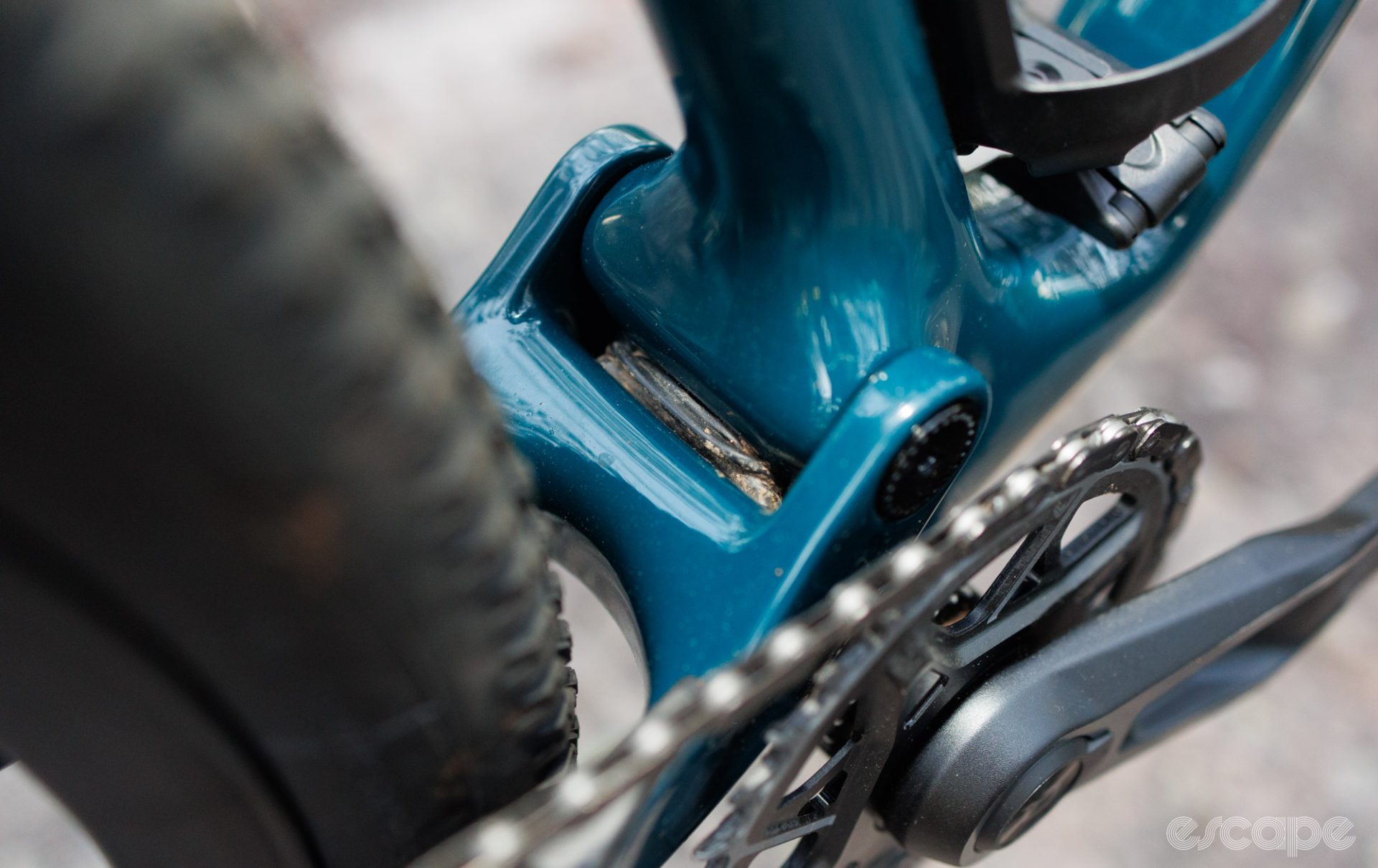
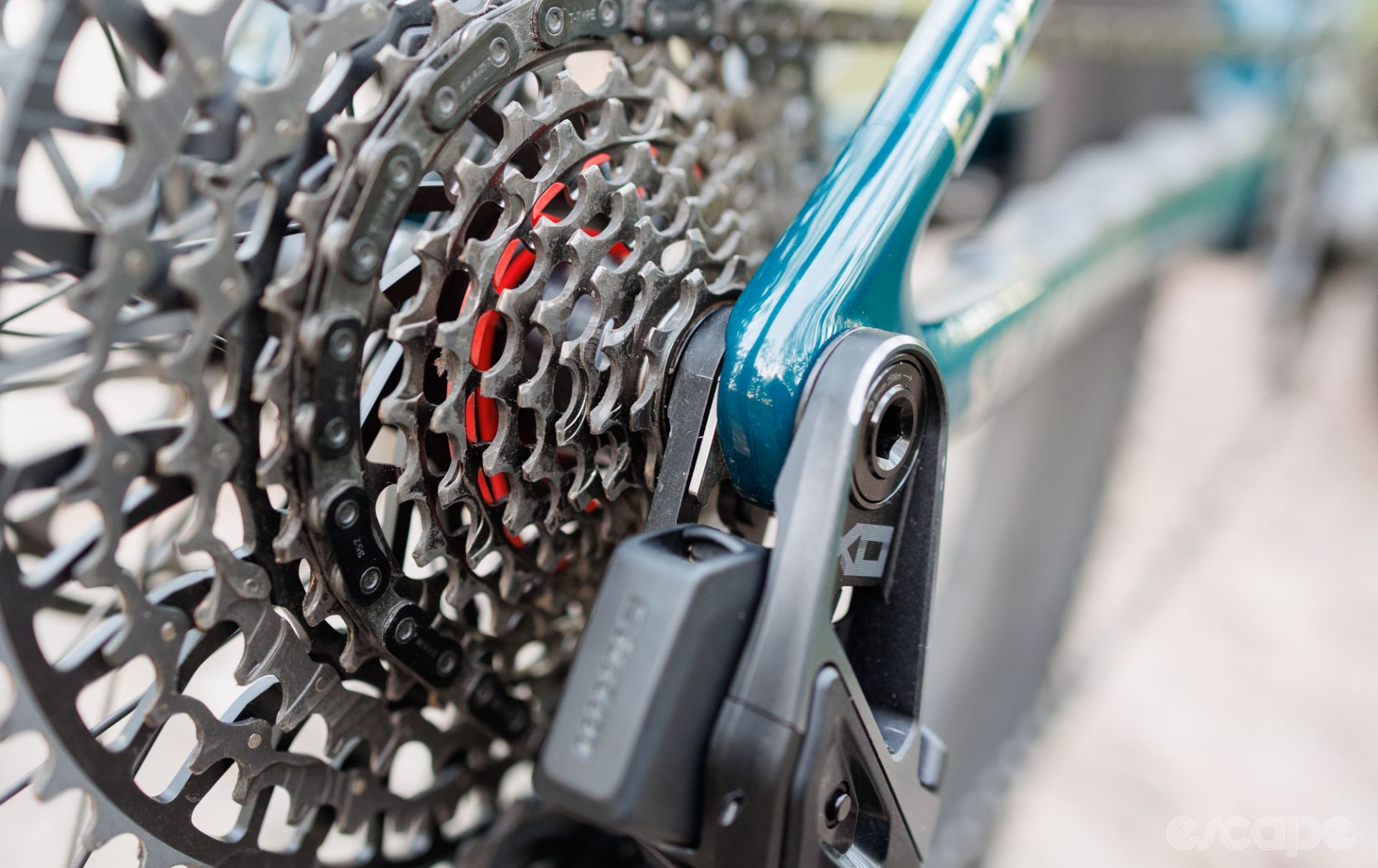
The new Epic WC defies its more limited suspension travel with progressive geometry figures. Across the four frame sizes, the head tube angles sit at a slack 66.5°, while the seat tube is at a far more traditional 74.5°. All sizes are based on the use of 29er wheels, and feature a 430 mm chainstay length and 57 mm bottom bracket drop (the small is at 58 mm).
Reach figures are now somewhat average for the genre and are designed to be run with a slightly shorter stem. For example, my tested medium offers a 440 mm reach and comes with a 70 mm stem length that felt just right. Stack figures are equally performance-focused, and riders shouldn’t have any issue in achieving a too-extreme bar drop with a change of stem. It’s also important to note that Specialized is only offering the extra-small size in the S-Works frameset, an arguably prohibitive option.
| Epic WC Geo | XS | S | M | L | XL |
|---|---|---|---|---|---|
| Seatpost Length | 370mm | 370mm | 415mm | 415mm | 415mm |
| Stack | 603mm | 600mm | 600mm | 614mm | 628mm |
| Reach | 380mm | 415mm | 440mm | 465mm | 490mm |
| Head Tube Length | 93mm | 93mm | 95mm | 110mm | 125mm |
| Head Tube Angle | 66.5° | 66.5° | 66.5° | 66.5° | 66.5° |
| BB Height | 309mm | 313mm | 313mm | 313mm | 313mm |
| BB Drop | 61mm | 58mm | 57mm | 57mm | 57mm |
| Trail | 113mm | 113mm | 113mm | 113mm | 113mm |
| Fork Length, Full | 516mm | 516mm | 516mm | 516mm | 516mm |
| Fork Rake/Offset | 44mm | 44mm | 44mm | 44mm | 44mm |
| Front Center | 665mm | 701mm | 726mm | 757mm | 788mm |
| Chainstay Length | 430mm | 430mm | 430mm | 430mm | 430mm |
| Wheelbase | 1089mm | 1124mm | 1150mm | 1181mm | 1212mm |
| Bike Standover Height | 738mm | 761mm | 764mm | 774mm | 786mm |
| Seat Tube Length | 392mm | 395mm | 410mm | 450mm | 500mm |
| Seat Tube Angle | 74.5° | 74.5° | 74.5° | 74.5° | 74.5° |
| Top Tube Length, Horizontal | 541mm | 581mm | 612mm | 641mm | 670mm |
Some of the figures may look odd, but it’s important to note the geometry of full-suspension bikes is dynamic, and the Epic WC’s numbers were designed around marginal sag. So for example, compared to the previous Epic, the seat tube is slacker, while the reach is shorter to match.
Talking suspension
OK, so let’s talk about that air spring and sag. Sag is how much the suspension spring compresses under your stationary weight (including riding gear) with no further forces put into the system. Running sag is a common design decision across almost all suspension forks and rear suspension systems as it allows the wheels to follow the varying contours of the trail – and not just bumps above the trail, but also holes below. Broadly speaking, it’s normal for most cross-country bikes to call for 20-25% sag, meaning if there’s 100 mm of travel, you’d sink into 20-25 mm of that just by sitting on the bike.
When you add air to a modern suspension fork or shock, you do so through the positive air chamber. That air then usually self-equalises into the negative air chamber to create an active spring. Rewind a decade or so and a number of suspension forks, such as the old noodly 28 mm-diameter RockShox SIDs, featured positive and negative air springs that you could tune independently. Most riders would choose even pressures in both chambers, but you could customise the ride by fiddling with the balance – run more pressure in the negative spring and the spring would be more reactive to small bumps, or reverse the ratio and you’d have a stiffer initial stroke that bobbed less under hard pedalling.
Specialized’s Epic WCID shock is using the same old concept to intentionally produce an initial firmness before the spring becomes active. However, instead of having two Schrader valves for fiddling with the pressure recipe – something RockShox has done with rear shocks before – you instead have a Schrader valve for the positive chamber, and a button-based valve that lets you manually draw different volumes of atmospheric pressure into the negative chamber. According to Brian Gordon, Specialized’s short travel mountain bike product manager, a key driver for not having two individual Schrader valves was to avoid consumer confusion and misuse – a lesson the company supposedly learned with its formerly ubiquitous AutoSag feature.
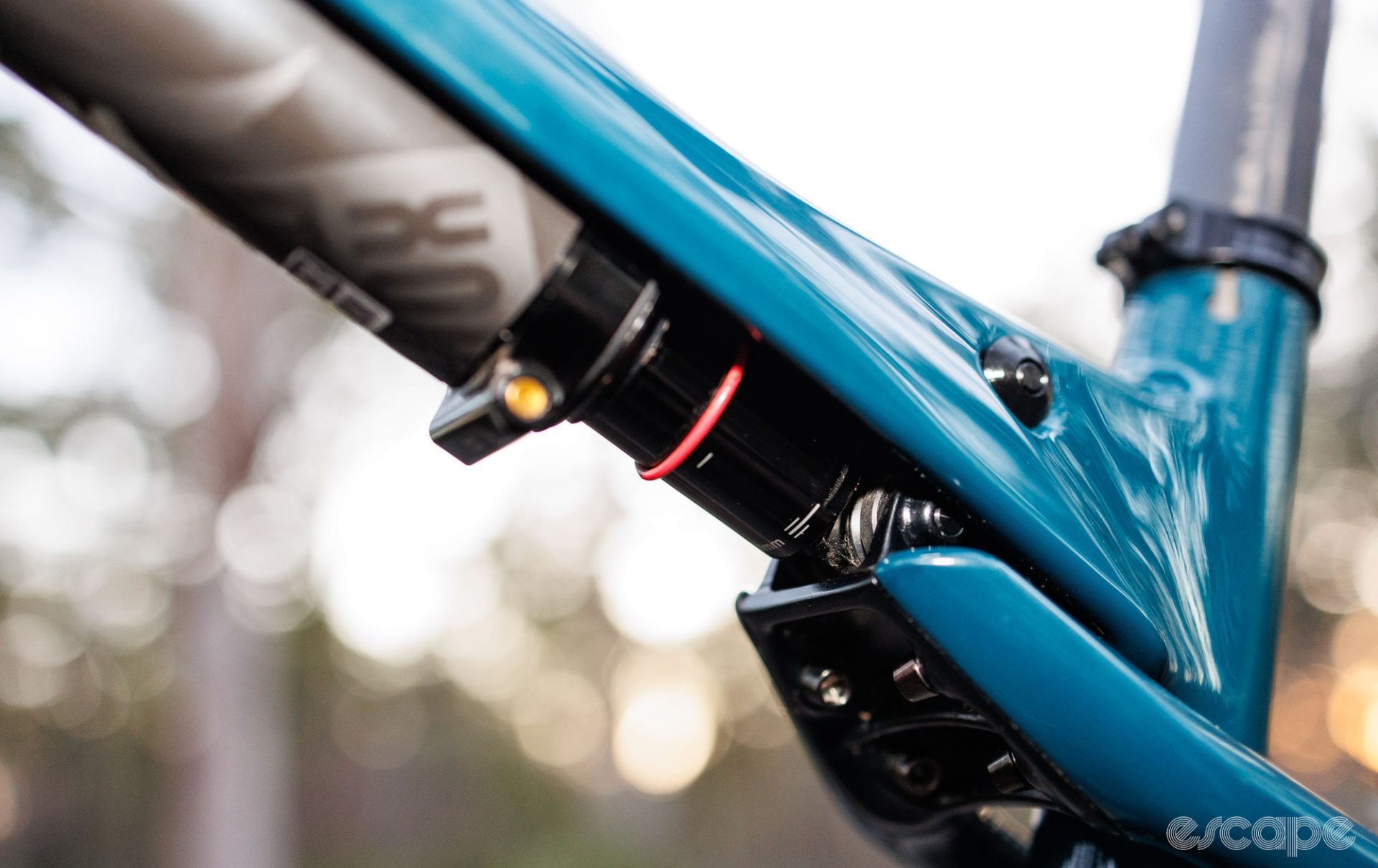
This drawing in of atmospheric pressure is what Specialized refers to as “Gulp”, and the Epic WC officially has three distinct Gulp settings available and clear guides on how to use them.
Providing the most hardtail-like riding experience, the Zero Gulp setting means there’s no pressure in the negative air spring and therefore the bike runs without any sag. In other words, the shock is topped out under your body weight and is entirely rigid under smooth pedalling forces. Giant used a similar concept with its NRS platform back in the early 2000s.
At its softest and most bump-reactive ‘Full Gulp” setting, the Epic WC offers just 10% sag. This figure isn’t much compared to the more usual 20-25% sag figures of almost all other cross-country race bikes. However, sitting higher up in its useable travel is how Specialized justifies the Epic WC having less travel.
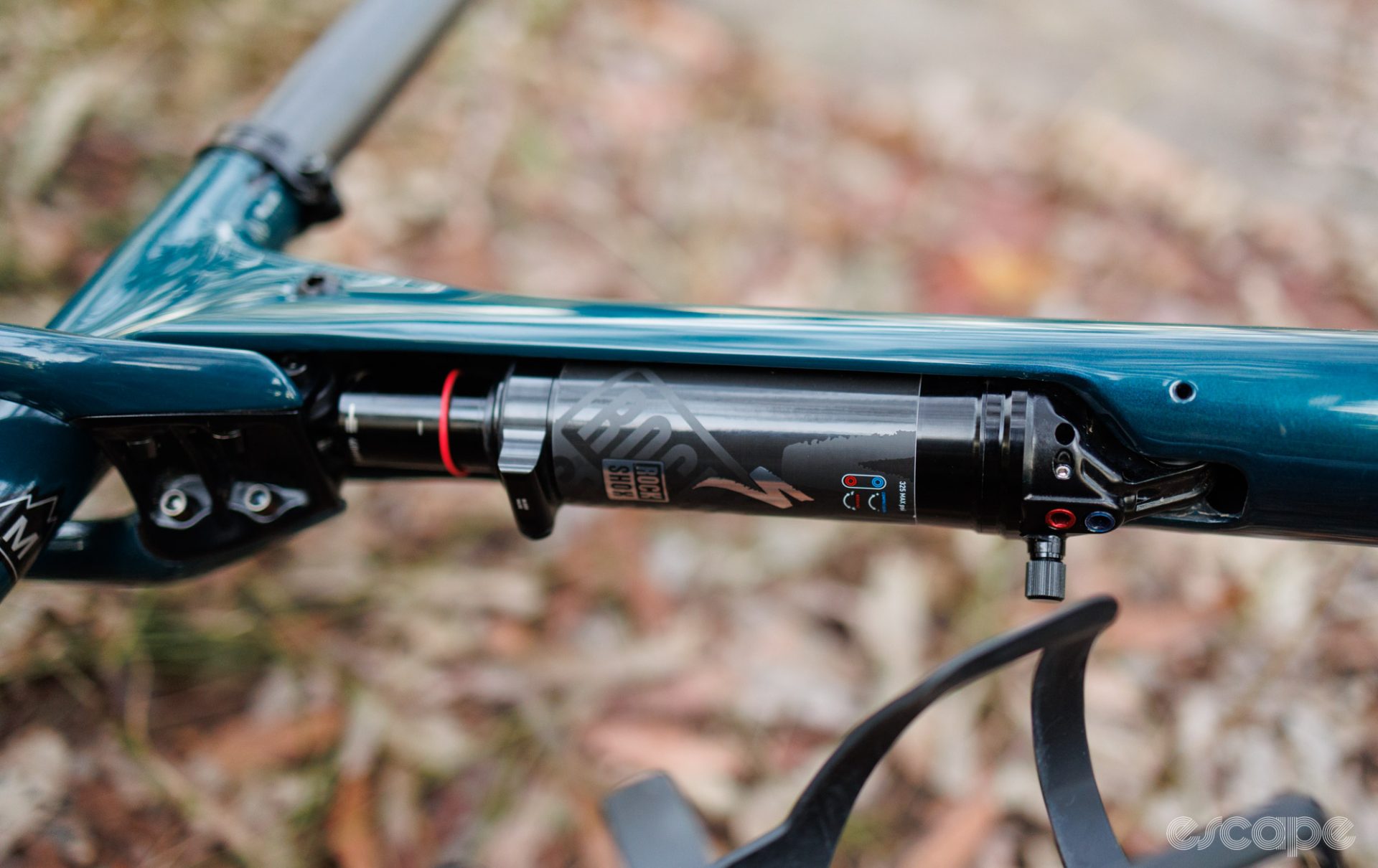
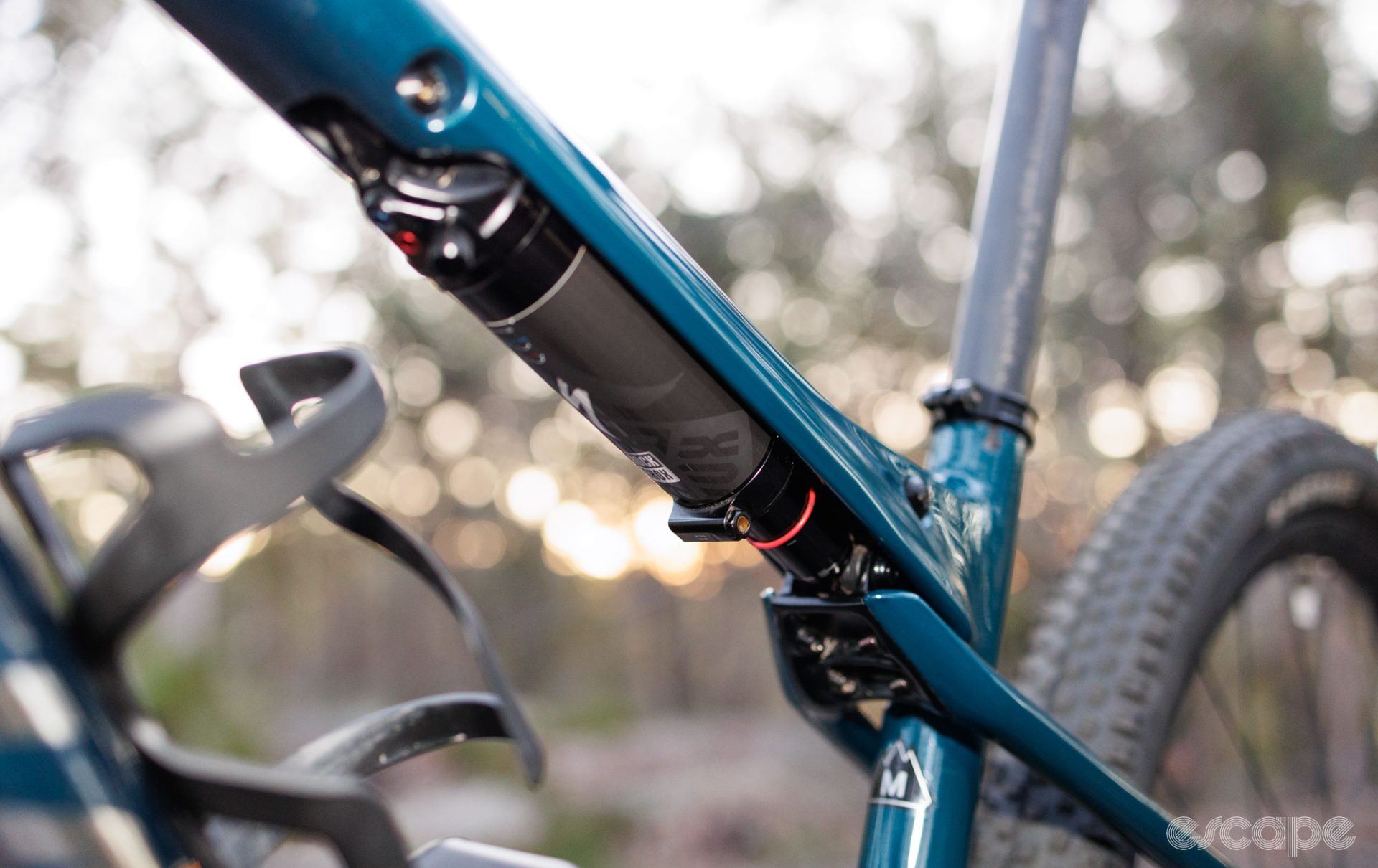
The third option is what I consider to be the Goldilocks setting, or what Specialized calls “Half Gulp,” where the system is run with a minimal 5% sag. According to Gordon, this is the setting that the likes of Laura Stigger and Chris Blevins use most.
Further complicating things, there’s also scope for running the shock outside of its recommended settings. For example, it’s possible to introduce subtly different amounts of atmospheric pressure to hit sag figures anywhere between 0-10%. Meanwhile, you can match those gulp settings with more or less pressure in the positive spring, which means you can achieve more than 10% sag, but as I’ll soon explain, you’ll be crying for a lock-out if you do.
It’s worth noting that while the Epic WC is designed to be stiff before the travel begins, that spring is incredibly linear once moving. Specialized intends the bike to use full travel on medium-sized hits and I’m told plenty of work was done with RockShox to provide an ample bottom-out bumper to prevent worries on large hits.
OK, so the use of atmospheric pressure in the negative spring raises the question of how the bike provides a consistent suspension experience to a broad range of rider weights. Gordon explained that it’s rarely just rider weight that impacts the suspension, but also rider size – and taller riders put more leverage on the suspension and therefore require more positive pressure, which only plays into the system’s limited sag design (at least up to the upper rider weight limit of 110 kg). Meanwhile, Gordon suggested that extremely light riders are more likely to experience the limitations of the system where they may not achieve enough sag without having to use an ultra-low pressure in the positive chamber – and for this, the company recommends installing air-volume-reducing spacers to make the spring more progressive (you can use up to three of these volume tokens). From my perspective, there are going to be compromises to those that fall on either side of the bell curve.

As for the front fork, both the Epic WC S-Works and Epic WC Pro versions James and I tested feature the same RockShox SID SL Ultimate with Specialized’s proprietary Brain-equipped damper. This is the recently revised chassis from RockShox, featuring 32 mm-diameter stanchions and an increased 110 mm of travel. Here, the Brain damper is designed to provide a locked-out feel when pedalling but opens the damper to bumps coming from beneath.
To help further smooth out the ride, this fork now runs with a minor 15 mm of sag, which means you’re effectively sitting against the Brain platform when set correctly, but with the fork still free to lift in its travel by a marginal amount. A knob on the right side of the crown adjusts the threshold of the force required to open the Brain damper.
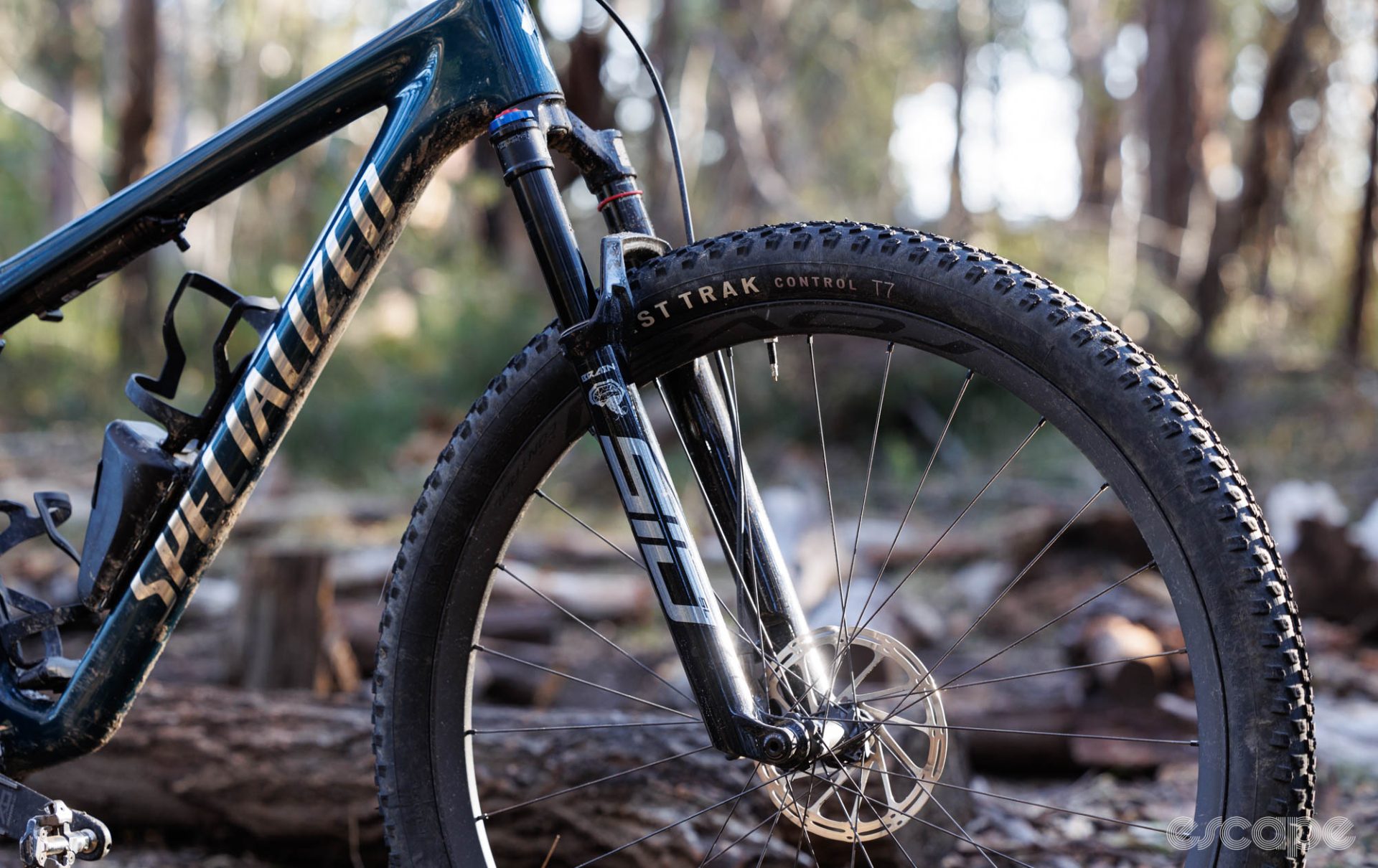
Parts, builds, and options
While exact options vary by region, in the USA Specialized offers three price tiers of the Epic WC, plus an S-Works frameset. None of the options are low in cost.
James tested the top-tier and team replica S-Works, a bike that carries a hefty price tag of US$12,000 / AU$18,900 / €12,500. Of course, for such a fee, you get the lightest frame option and top-tier components. There’s a full SRAM XX SL transmission with power meter (in the narrower 168 mm Q-factor, too), Roval’s 1,240 g Control SL wheels, and the new one-piece Roval Control SL handlebar/stem.
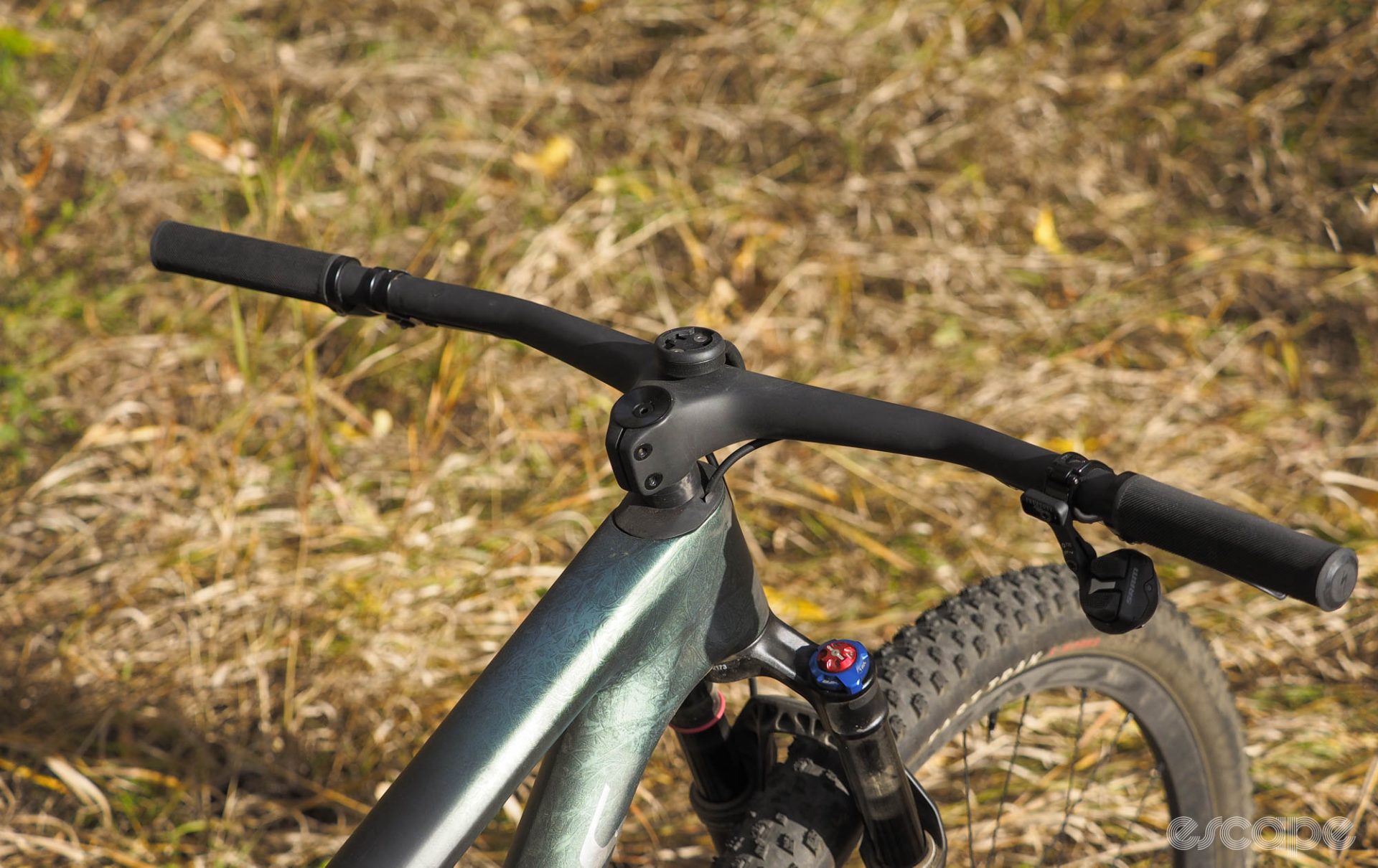
I tested the Epic WC Pro, which is still a lot of money at US$9,000 / AU$13,900 / €9,000. The second-tier frame is marginally heavier, but the suspension package is identical to the S-Works. Further costs are saved throughout with the move away from the Roval one-piece bar and stem to what I consider to be a more favourable two-piece setup with Roval’s S-Works Carbon XC Mini Rise. The Roval Control wheels feature an identical rim to what’s on the S-Works bike, but the hubs are changed to DT Swiss 350s and the spokes are double-butted and round in shape. You also still get a SRAM Transmission AXS groupset (with spindle-based Quarq power meter), albeit at the XO level with lots more aluminium pieces and a wider crank Q-factor (174 mm).
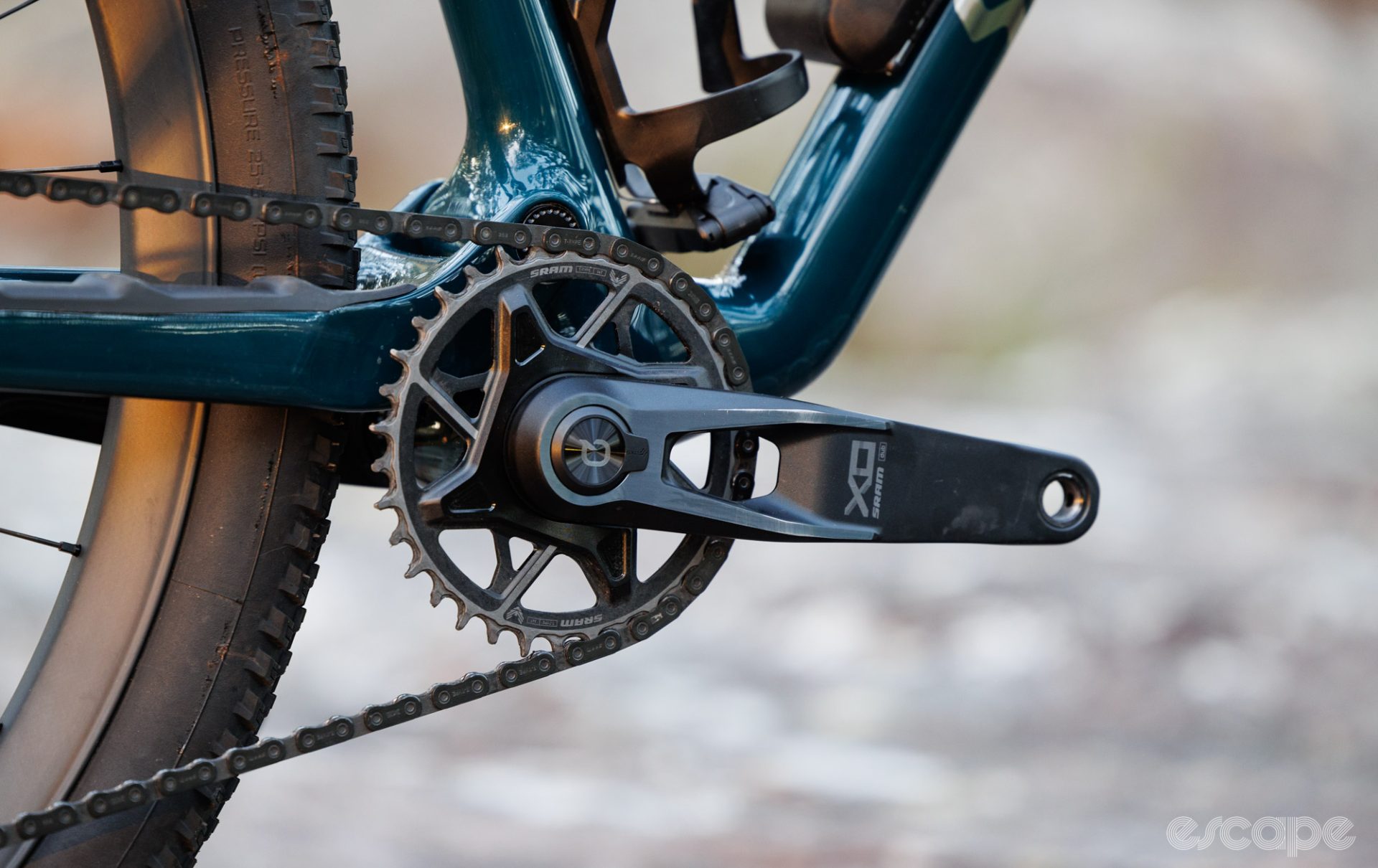
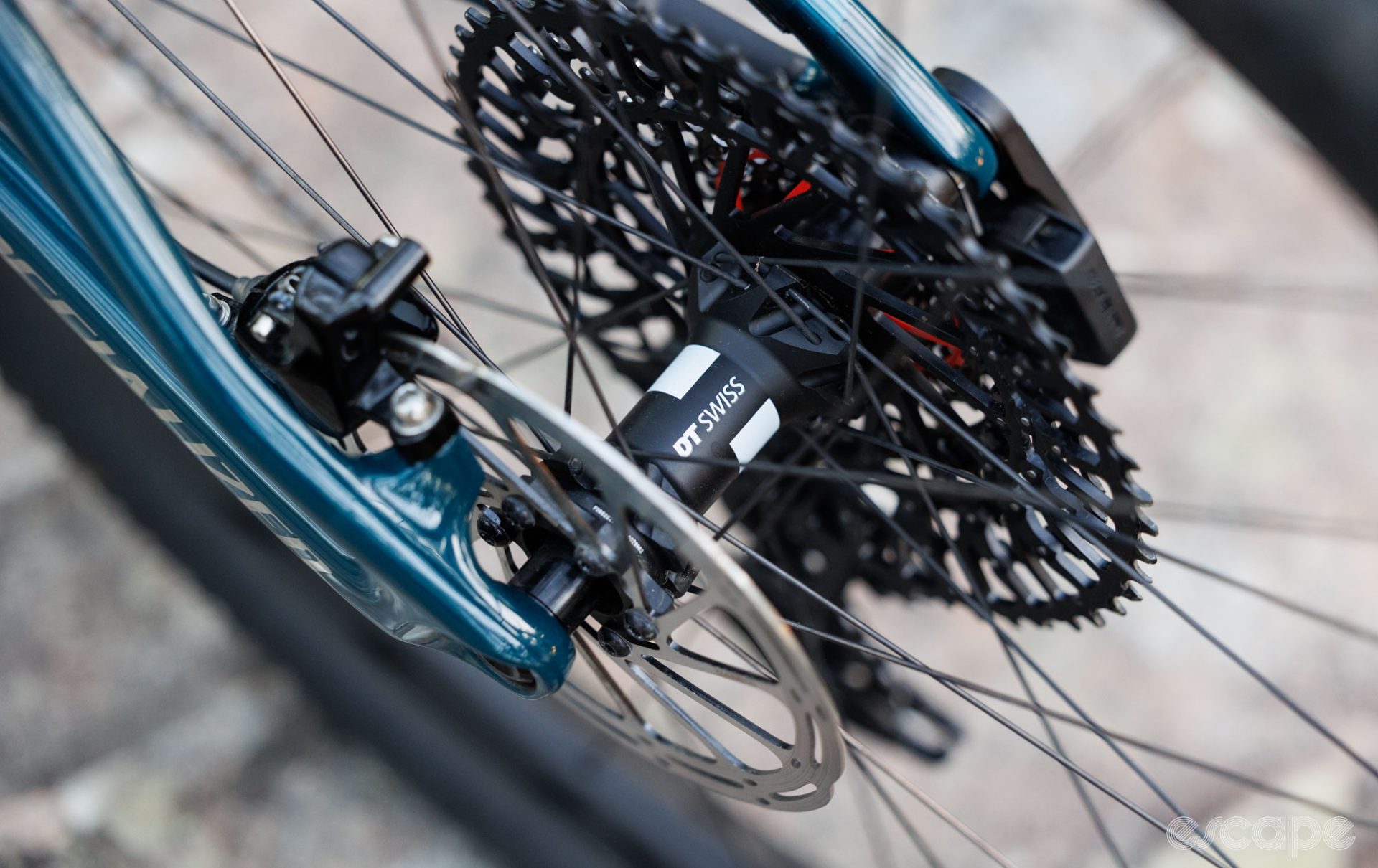
Not tested was the Epic WC Expert at US$7,000 / AU$10,400 / €7,200. This uses the same frame and rear shock. Surprisingly, the Control Carbon wheelset is also featured, as is the same Specialized Fast Trak (front) and Renegade (rear) 29 x 2.35″ tyre package found on the S-Works and Pro bikes. However, the Brain-equipped SID SL features a slightly heavier construction. Meanwhile, the Pro’s lightweight carbon seatpost and handlebar are traded for aluminium units, while the drivetrain remains SRAM’s AXS Transmission, albeit at a base GX level.
Want Shimano? That may require the frameset route but expect to pay US$6,000 / AU$8,900 / €6,500 for an S-Works frameset with a Brain-equipped SID SL Ultimate fork and rigid seatpost you may not use.
Likely to add further to the already chunky purchase price and bump up the claimed weights is the fact that Specialized has left the purchase of a dropper post to the customer, and instead equips all of its Epic WC bikes with rigid seatposts (nice carbon ones for the bikes reviewed here). According to Gordon, this polarising decision was consciously made based on how many of the customers for this bike still choose to use rigid posts. Adding to that, those who want a dropper on a bike of this level typically have strong feelings over whether they want a heavier wireless model, an infinitely adjustable lightweight one like the BikeYoke Divine SL, or a lighter fixed-position dropper like the Fox Transfer SL. And then there’s the even bigger decision over how much travel you want.
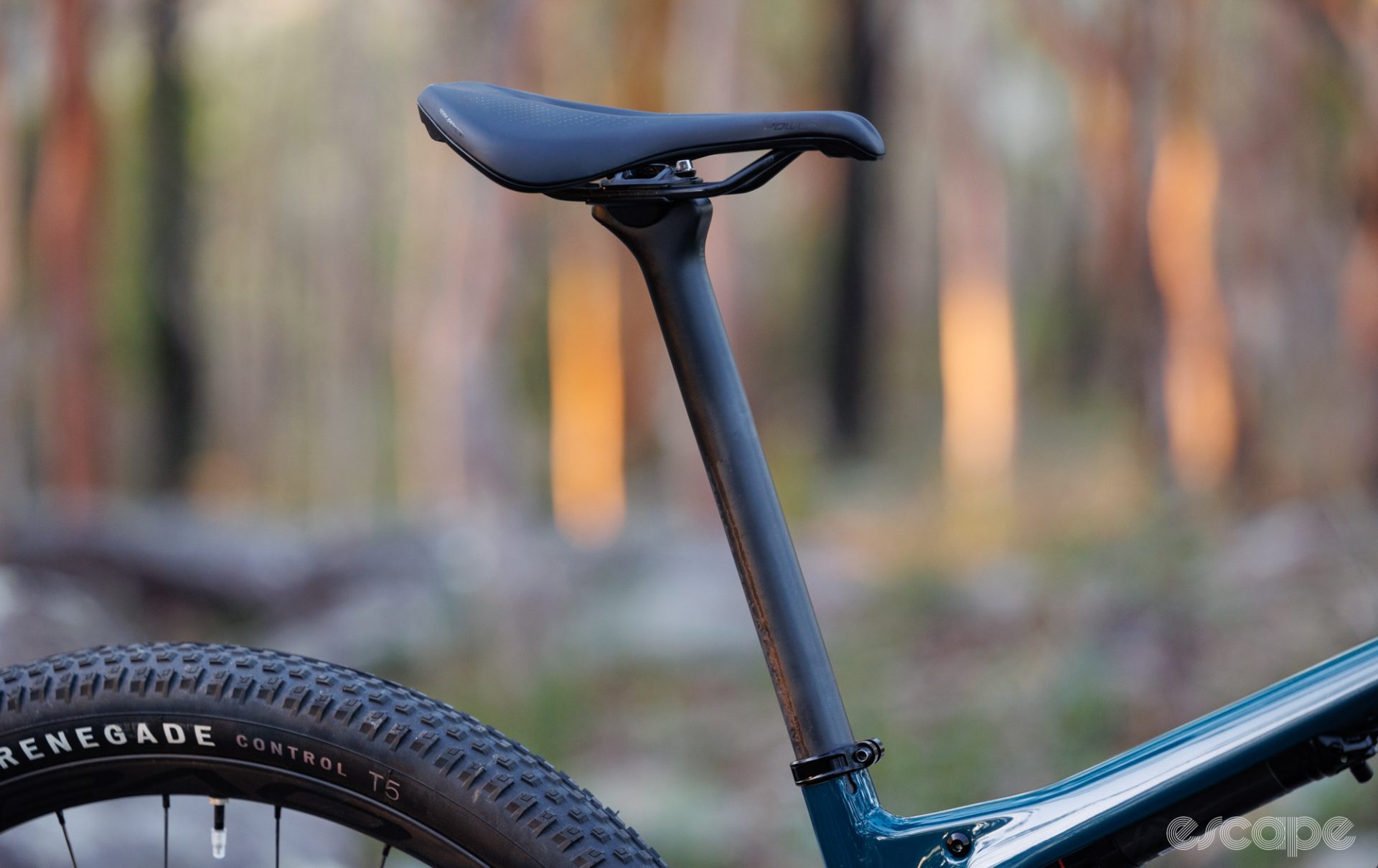
I can understand why Specialized made this decision, but I sure hope this doesn’t become a trend. Even if this bike was a pure hardtail I’d still want it to come with a dropper!
The bikes also include a pair of Specialized’s fantastic side-access bottle cages, the down tube-mounted SWAT box (not provided on the Expert model), and a matching multi-tool. Specialized introduced its SWAT box many iterations of the Epic ago, and truthfully, my eyes are still pained by it. It serves the function of carrying an emergency flat kit, but careful packing is required to prevent rattles, and it’s limiting over what fits. Thankfully it’s also easily removed.
How it rides
I believe preferences are crucially important when talking about cross-country race bikes. Me? I prefer bikes that are set-and-forget with their suspension. By this, I mean I like a bike that pedals efficiently without feeling like I have to flick a handlebar lever or reach down to the shock to make it go uphill. Plus, I strongly dislike a cluttered cockpit … I want my left hand to control a dropper post and nothing else. I also have a soft spot for hardtails, and while they make little sense on my local trails, I get a thrill out of the low weight and instant response they provide.
In theory, I’m the customer for the Epic WC. And yet, I found it to be more set-and-try-to-forget. Mountain biking is a dynamic sport with forever-varying terrain, and so on every ride, and no matter how I fettled with the suspension, I would find myself wanting more, or less, or just something else.
Setting the suspension with No Gulp (0% sag), the Epic EC offers an undeniable pedalling efficiency that feels hardtail-like. Combined with adjusting the Brain fork to a firmer setting (aka threshold), the bike quite remarkably feels rigid to pedalling input, even when out of the saddle. It’s pure joy on the road or hardpack ground where gravel bikes glide best.
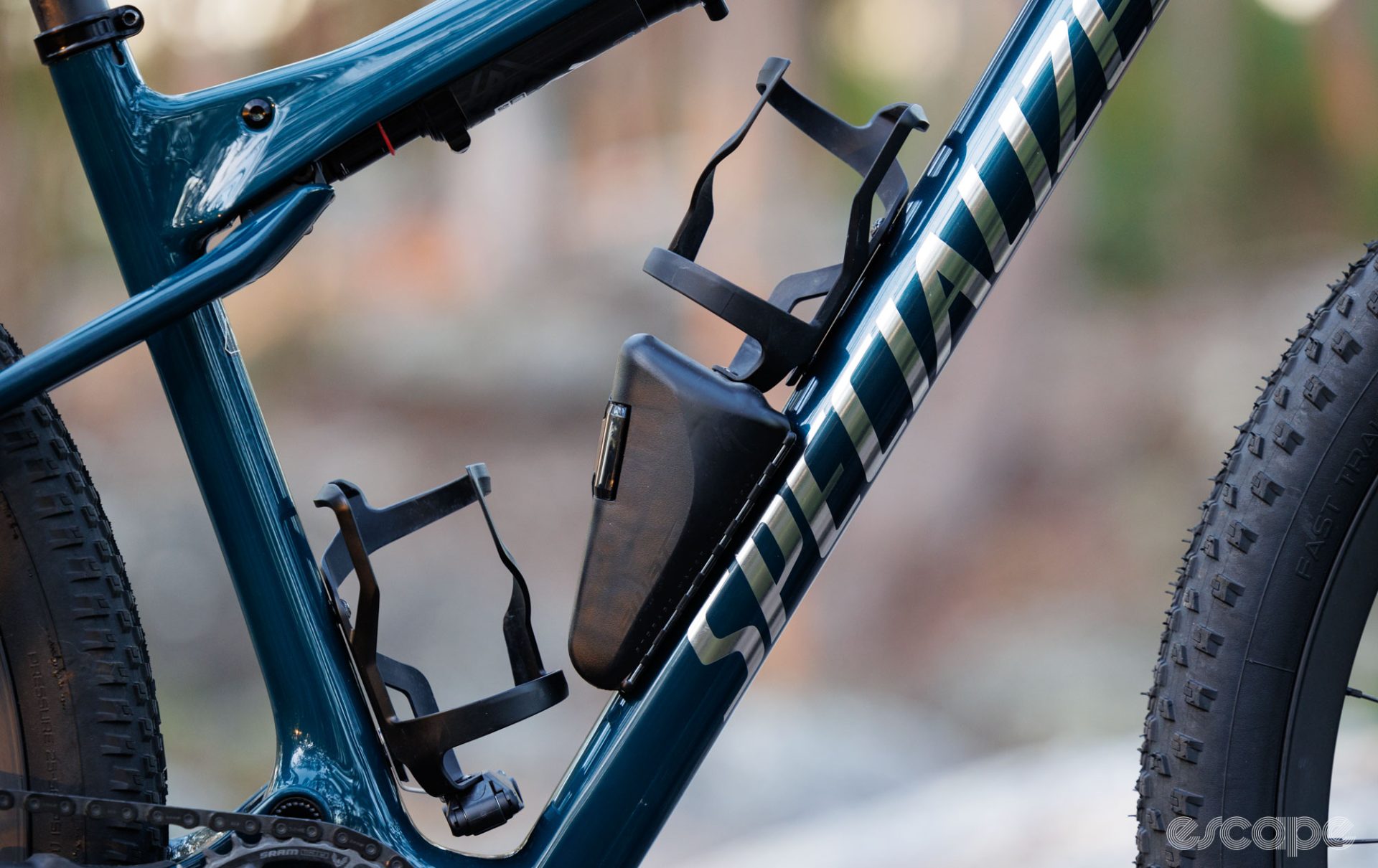
Medium to large impacts are absorbed with impressive efficiency, and you can feel that the rear wheel doesn’t get as hung up on square edges like a hardtail does. These more obvious impacts have the 75 mm of rear travel feel far more generous than the number suggests, and a few times I spotted the travel-indicating o-ring had been pushed off the shock shaft, and yet at no times had I felt a harsh bottom out, or even what I thought was a bottom out.
These larger compressions also give a feeling very reminiscent of the previous generations of Epic. Hitting a bump or the lip of something has an obvious firmness, almost a harshness, but on touchdown, the bike is smooth and well-damped. There’s a learning curve to it, and the Epic WC tends to give more pop to getting the wheels off the ground.
The progressive geometry is sensationally good and shines when pushed into bigger impacts, with the slack head tube angle providing plenty of confidence in clearing such obstacles. It’s a geometry that encourages you to descend with this bike in a way that can quickly out-pace the suspension, and so it’s good that it feels so bottomless out back.
The slacked-out front end and slacker seat tube angle both play nicely into using a rigid seatpost. It’s this extra stability that didn’t have me missing the dropper as much as I first thought I would. Still, I ended up stealing the Reverb AXS dropper off my own hardtail as my skills of high-posting on technical descents are more than rusty.
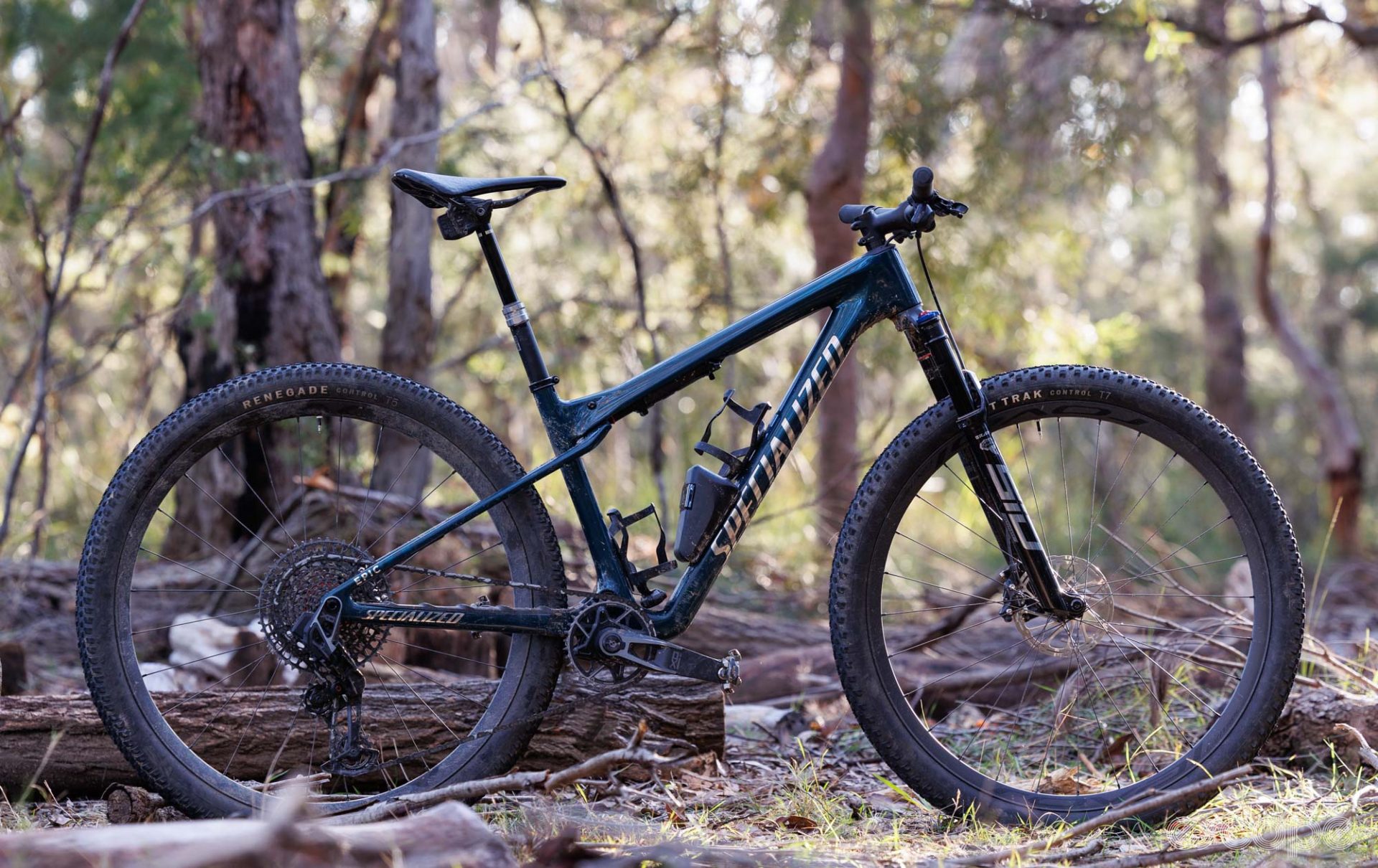
Unfortunately, it’s the smaller bump compliance that the 0% sag setting so clearly lacks. Hit a rocky or rooty climb with enough speed and the rear wheel will bounce like a hardtail. Take a fast, loose corner and the wheel won’t hang on like a bike sitting deep in its sag. Try to pedal over a rough false-flat and you’ll feel it through your bones. Or as James more harshly put it, the Epic WC reminded him of “the old Giant NRS, and not in good ways.” Ouch.
At the opposite end, setting the bike to its Full Gulp setting (10% sag) provided a bike that began to behave off-road like you should expect of a good full suspension. In this max-boing setting the bike still feels comparatively reactive under power as it’s sitting high in its travel, but it manages to be far more reactive over the fatiguing smaller bump stuff. With sag, you can now pedal the bike seated through those choppy false-flats, and you gain some level of traction on loose terrain. And while the bike still feels rather stiff to input, you can see the shock actively working to the demands of the rear wheel.
And yet, at times this 10% sag had me wishing for a lockout. The desire for a lockout isn’t even all about fear of energy losses, but rather about out-of-the-saddle road climbs. When imitating my best sprint finish, I found the suspension movement was enough to impact my pedalling rhythm, and oddly enough, more so than a bike that sags even further into its travel. Perhaps it’s the limited anti-squat in the kinematics, something fellow bike reviewer Guy Kesteven touched on, or maybe it’s merely that the shock is bouncing between a sagged and topped-out position. Either way, I didn’t get used to it, and Trek’s Supercaliber seems to be answering my call.

And that brings me to the Goldilocks setting, the Half Gulp (5% sag). It’s here that I found the most happiness in a bike that was noticeably efficient-feeling on the pedals, but slightly easier on the body and faster than a hardtail. To me, this setting provides the least amount of compromise, but the dynamic nature of mountain biking is indeed a hard nut to crack. At times you want a hardtail-like pedalling experience, and at other times you want it to feel like a full-blown trail bike, and the Epic WC felt like it stuck somewhere in the middle.
Not helping this experience was the Brain front fork. A long-standing issue with Specialized’s Brain-equipped suspension components is the motion required to open the damper. While this has greatly improved over the years, it has proven to be a stubborn byproduct of having such an anti-bob platform. Even when fully open, the Brain-equipped fork kept the classic light thunk, and that thunk happens in time with a subtle jarring sensation.
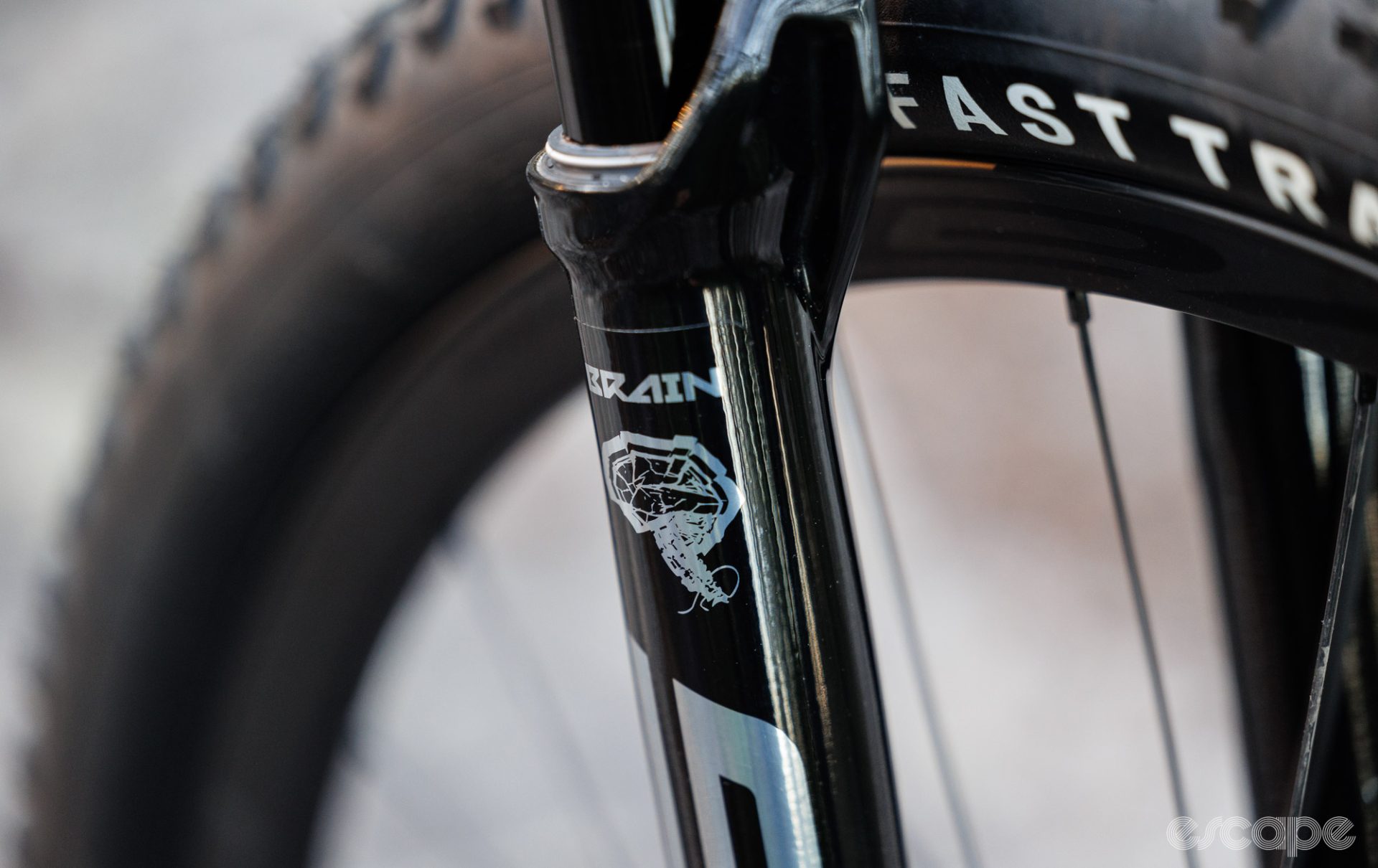
Even having the threshold set all the way open revealed a strange sensation on slow and technical climbs. Here, I found myself missing the grip and positional benefits from the additional sag you can get when weighting the front of the bike, and as a result, the front end felt a little taller and more vague than a number of the Epic’s steeper-angled competitors.
Perhaps my biggest pet peeve is how fatiguing I found the fork to be. Going out for a quick lunch ride would have me feeling it through my upper body within just 30 minutes. The compression spike to get both the front and rear shocks moving means the bike doesn’t hide the trail from you, and in turn, it just feels more taxing to keep the bike at speed over rough or technical terrain.
And it’s this fatigue that then had me wishing for a bike with more active travel front and rear, which I could then choose to turn off when hitting the road or an extended long and smooth climb. Critically, such a longer-travel bike is easily possible without a noticeable weight gain over the Epic WC.
Thoughts on the build and spec
To add some positivity back into this, I will give props to Specialized for the generally high-quality build. The frame hardware and stiff pivot connections should help to provide good longevity from the frame bearings. Equally, this bike will be an easy one to service, with the rear shock held by two eyelet bolts like most other frames. And that mostly normal shock has some nice features for increased durability, such as a longer internal bushing for greater flex resistance.
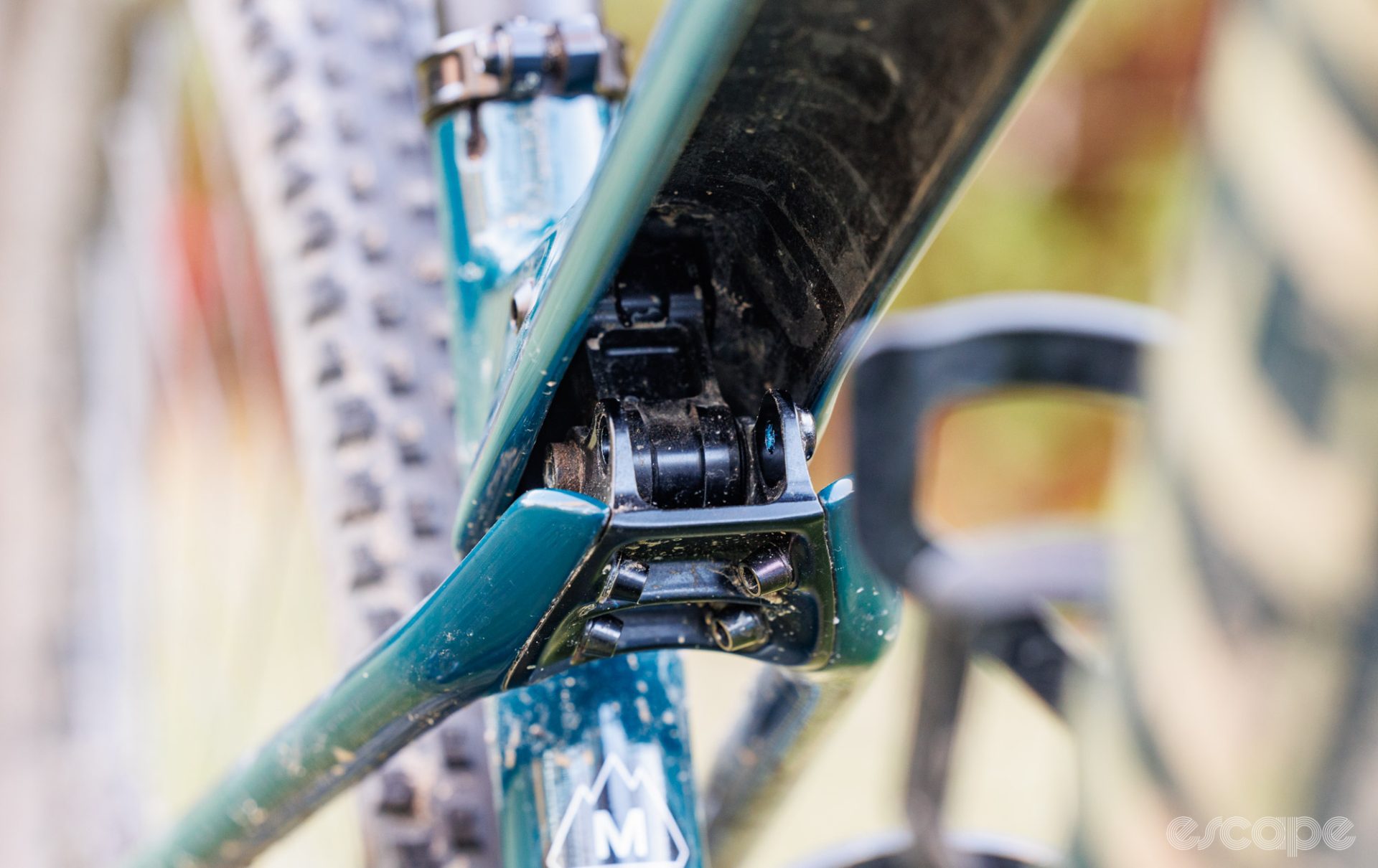
With no remote lockouts and AXS shifting I really don’t have much issue with the through-headset cable routing. Out of the box Specialized has produced the cleanest looking full suspension bike on the market. It also isn’t all that much harder to drop the fork out of, and replacing the top headset bearing only requires a single brake hose to be undone.
As someone who took a file to their Trek KnockBlock in order to open up the turning circle, I’m happy to say that the Epic WC’s steering range is ample, so further kudos to Specialized for creating a clean-looking steering stopper that goes unnoticed.
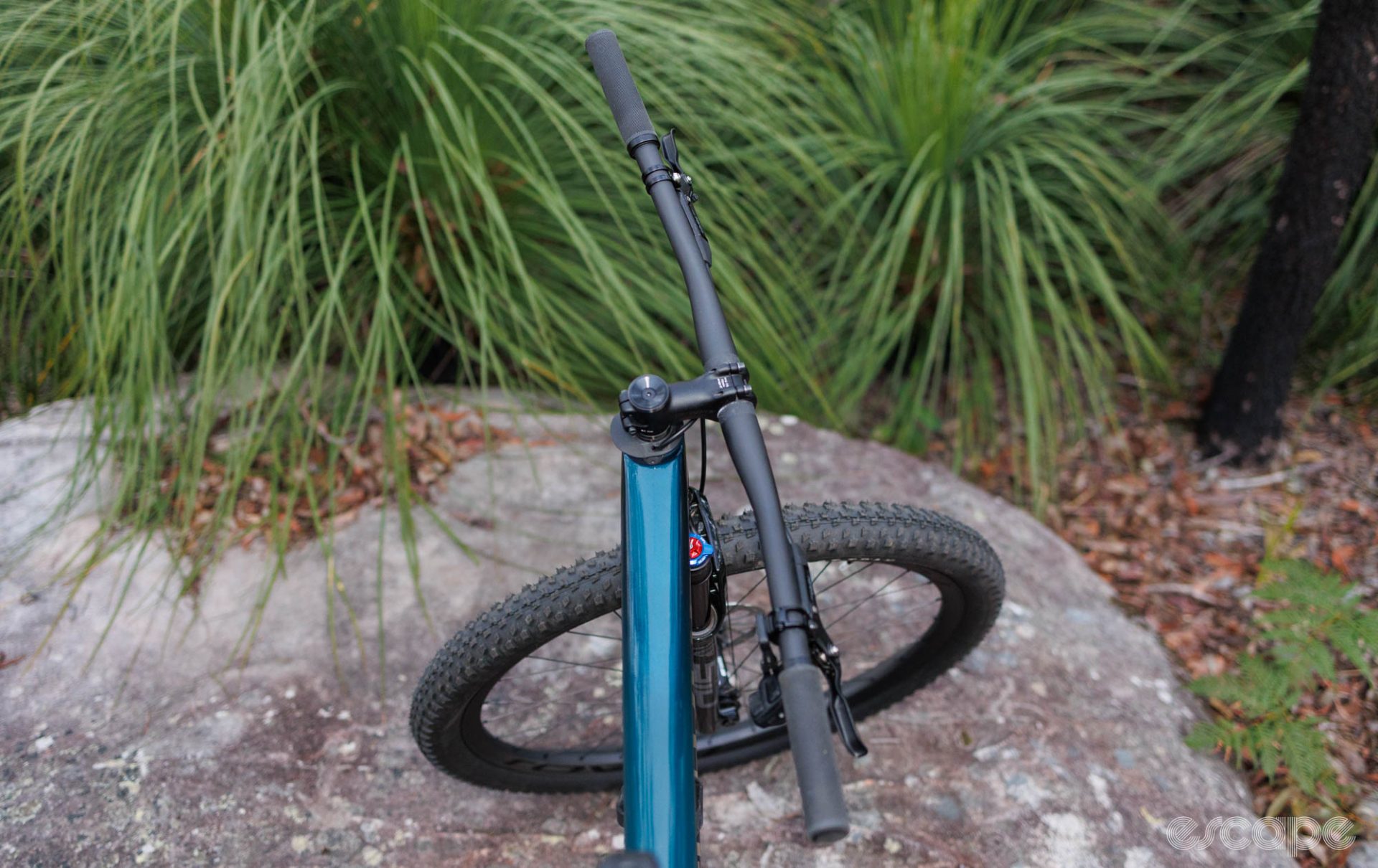
The pain of internal cable routing does grow though as you add more cables, such as a cable-actuated dropper post. And unfortunately, the whole design is let down by a rubber cover that after only a couple of months of use showed signs of marring the paint it turns on. Adding to that, by the end of my test period I found layers of thick grit sitting on the top headset bearing, and there were also signs of the brake hose starting to abrade against the inside race of the bearing. It’s a good thing the frame pivots feel robust, because the headset bearings are likely to need annual replacement.
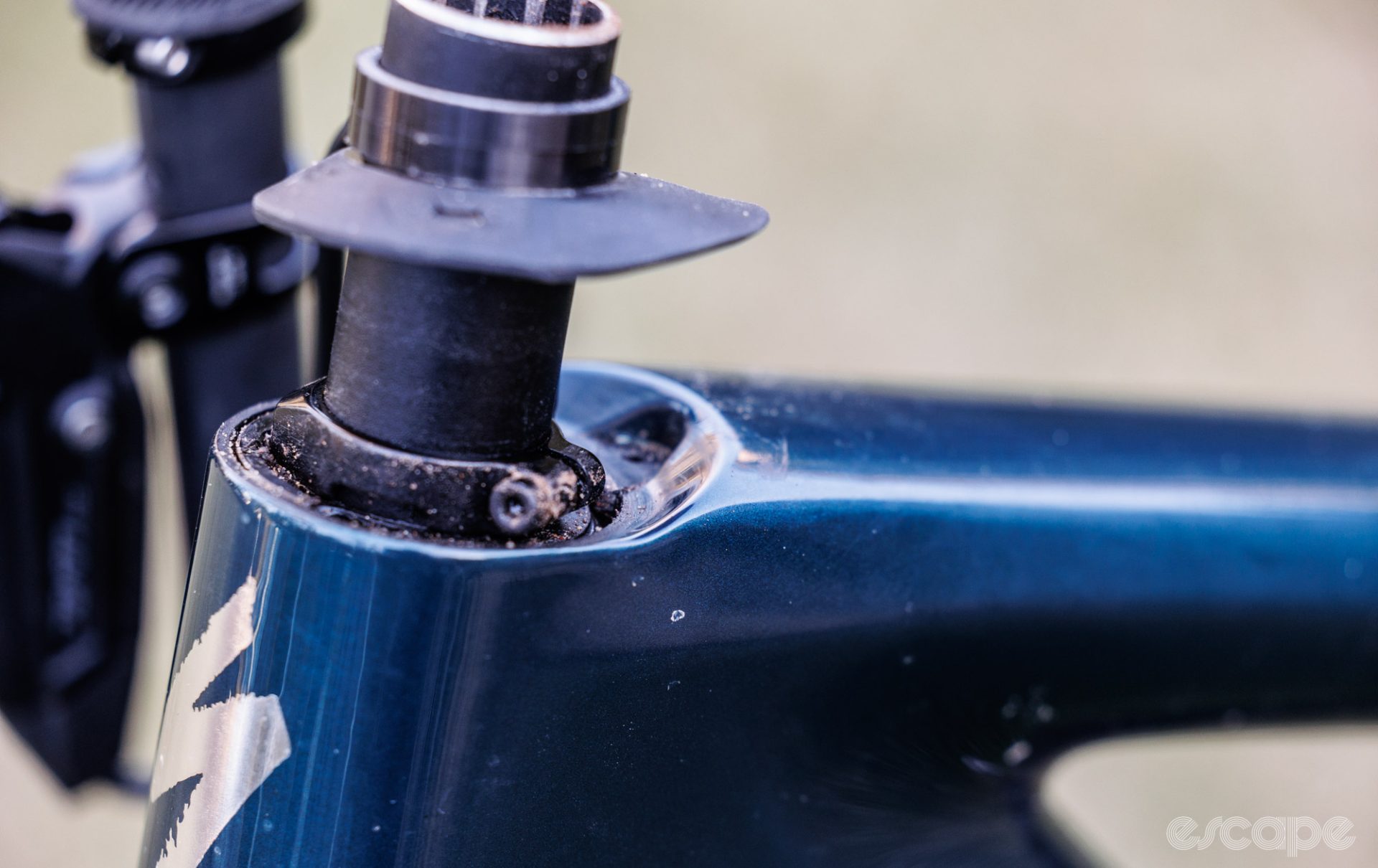
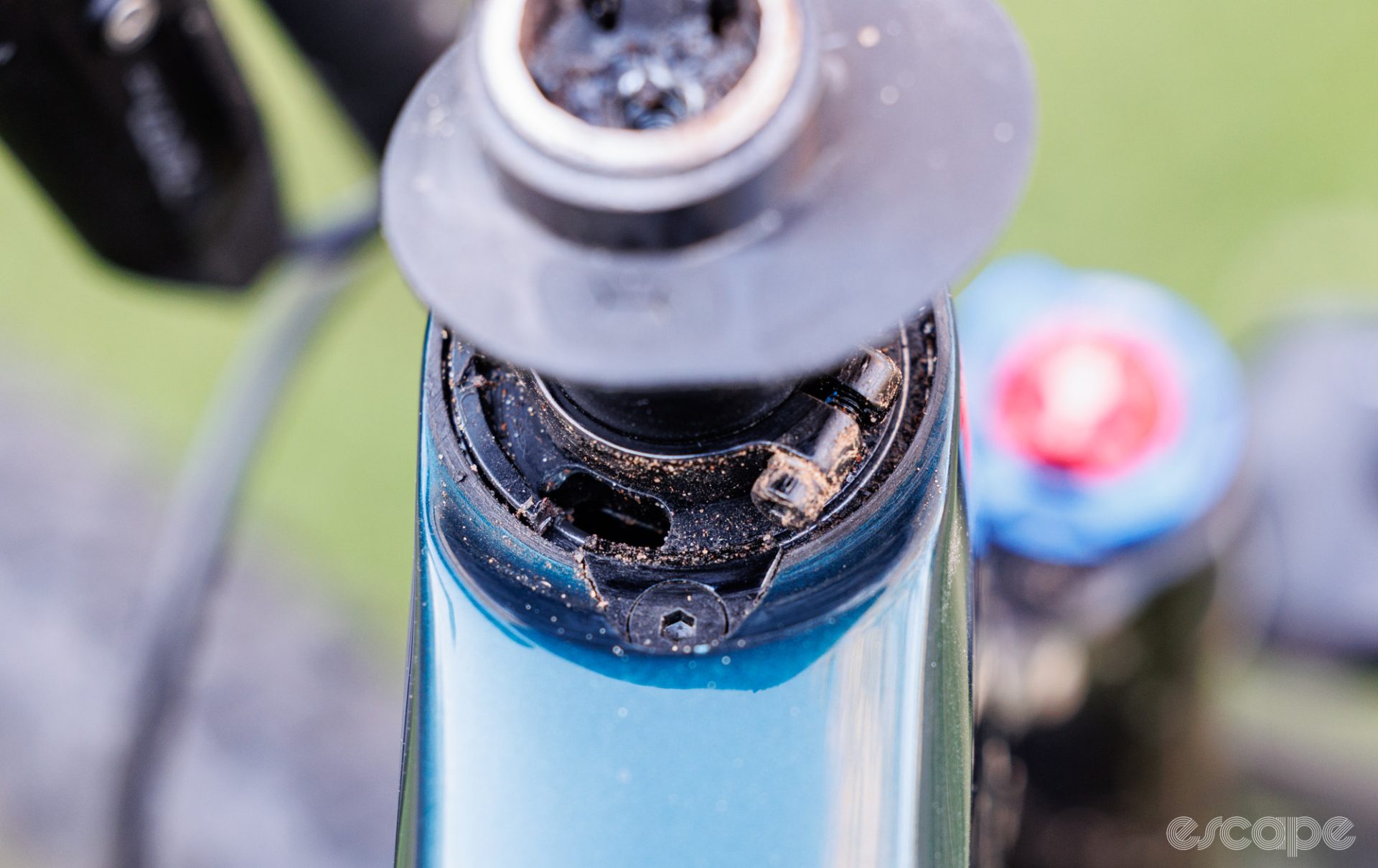
Parts-wise the Epic WC Pro is super solid. The SRAM X0 Transmission shifts exactly the same as the top-tier XX SL kit, just with more weight and no stress about what you smash the aluminium cranks into. This drivetrain is immensely solid against the rigours of riding off-road, it shifts better than anything else under power, and there’s nothing to adjust or straighten. Also, including a spindle-based power meter (left-side-only measurement) is a nice touch.
That said, some riders (such as James) will be bothered by the slowness of shifting multiple gears in one go [I think single shifts are slow, too, Dave – James]. The pod shifter is a little quirky in how polarising its ergonomics have proven to be. The XO cranks have a Q-factor that’s not ideal for people conditioned to riding narrower road and gravel bikes. And then there’s the simple fact that this stuff isn’t exactly light for the purpose of racing cross-country. Still, all it takes is one crash on the driveside and you’ll appreciate having it.

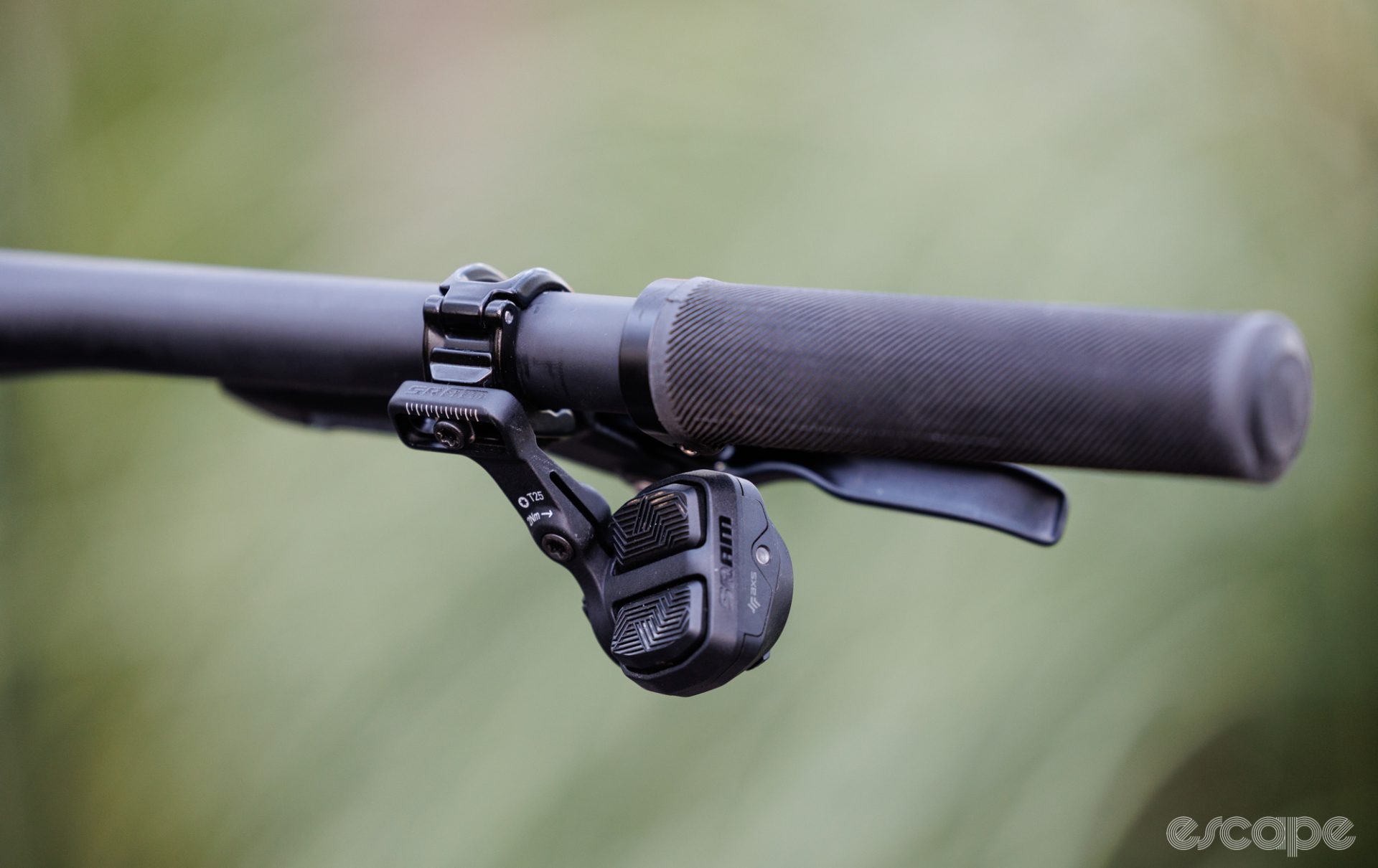
SRAM’s matching Level Stealth Silver brakes (with two-piston calipers) were reliable but left me underwhelmed in terms of lever feel and braking power. I found there to be far too much dead stroke (lever movement that does nothing) when running the lever closer to the bar, while a larger 180 mm rotor on the medium size would probably help to solve the power woes.
The wheel stock was solid, and truthfully I couldn’t ask for much better. Those Roval Control Carbons are the same wheels I chose for my own hardtail – with an ultralight rim combined and the forever-reliable DT Swiss 350 hubs they’re a solid choice. Meanwhile, the Specialized Fast Trak and Renegade tyres offered generous volume and a nice balance between traction and rolling speed on both hard-pack and lightly rocked terrain.
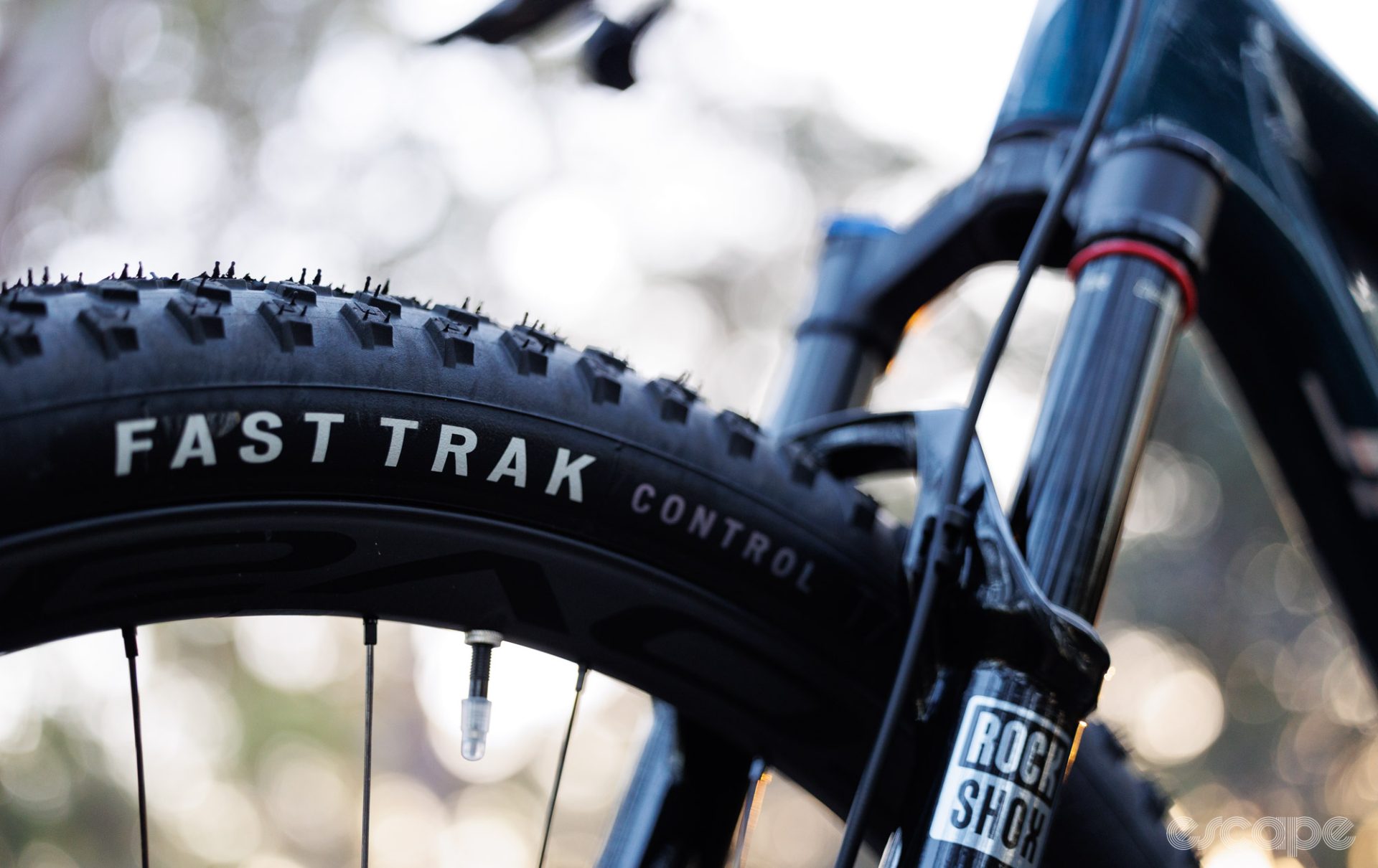

The touch points are more of a mixed bag. It’s a good thing the slim rubber lock-on grips are so cheap to replace because they need to go. I love the carbon mini riser handlebar, although its 760 mm width will have owners reading my guide to cutting carbon components. The Specialized Power saddle is likely to suit many, and if for some reason you want a rigid post, then at least a good one is given. Of course, I wanted (and added) a dropper, and while I can understand why Specialized left this as a choice, the bike is already expensive enough without then having to fork out another $300-700 for a good dropper.
An elephant in the room
Anyone who followed the 2023 World Cup Cross-Country series is likely to have noticed that the Specialized Factory Racing team didn’t consistently use its “World Cup” bike this year; rather the Epic Evo was seen more regularly. Speaking with Gordon on this, there are a few factors at play.
“Looking at the World Cup tracks, we knew [the Epic WC] wasn’t going to work for everything,” he said. “For the hardtail courses, we knew our riders could go faster with rear suspension.” However, even on hardtail-friendly courses, we’ve still seen some team riders pick the Epic Evo, and most recently, with RockShox’s still-prototype Flight Attendant electronic suspension.
According to Gordon, much of this comes down to familiarity. “The riders typically train on their Epic Evos and that’s because it’s the more fun bike to ride your local trails on,” he said. “So when Sina [Frei] did her timed testing, she said she’d just ridden her Epic Evo for two months vs the day on the Epic WC, and therefore felt more comfortable on the Evo. Her choice was to focus on one bike for the season. Laura [Stigger] has been on the Epic WC every race (and recently won on it). Meanwhile, other riders switch between them. It’s really rider-dependent and we give them the option.”
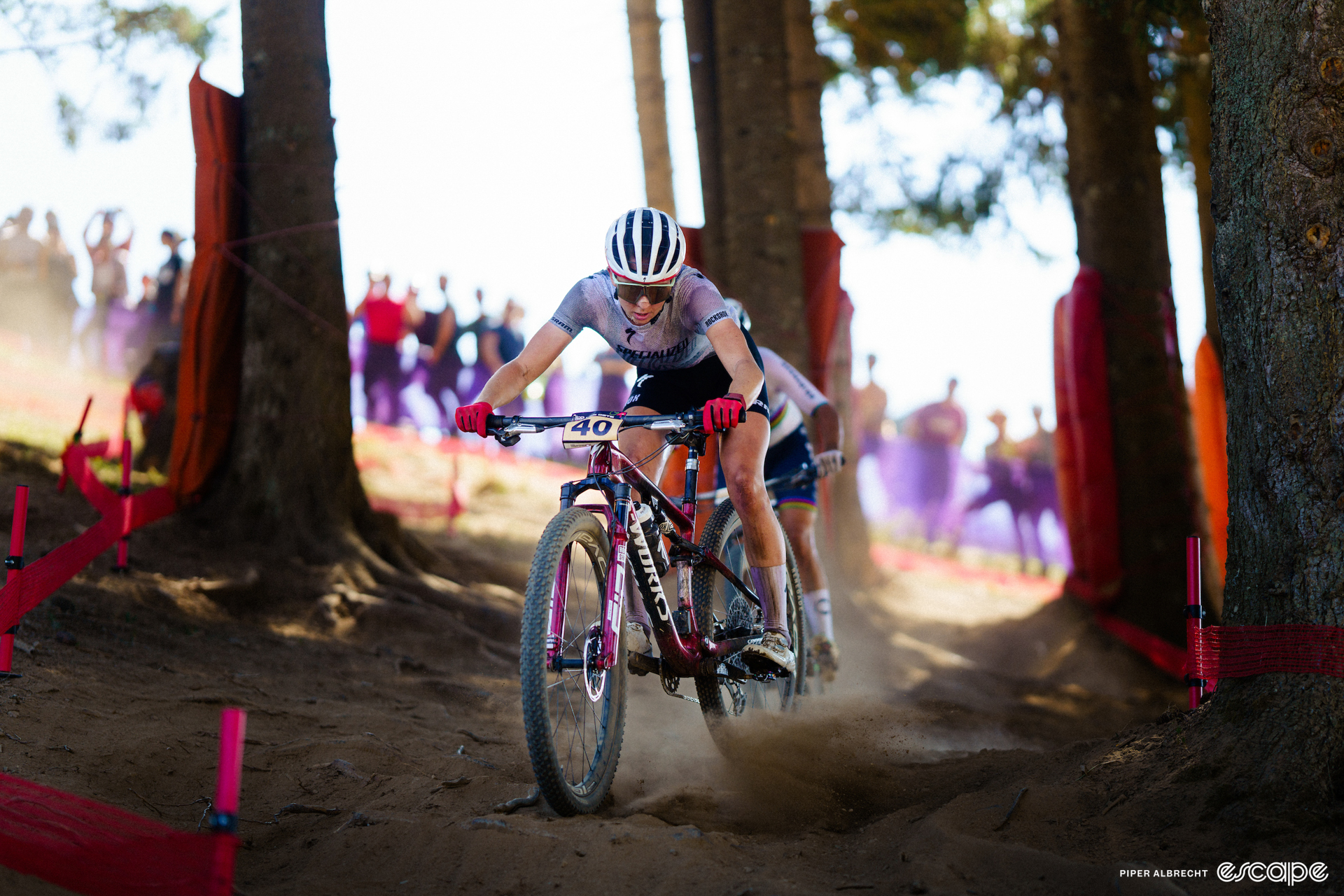
Arguably the biggest driving force is that a lot of modern World Cup tracks are rather insane and it’s not uncommon to see professional riders walking sections (at least in adverse weather) or taking the B-line. “These tracks demand way more than what any local race promoter would ever run an amateur race on,” Gordon said. “So we see this as a key thing, where World Cup riders need something more.” Add in speeds that the top riders hit such features with and it makes more sense why so many of them have shifted to often-heavier bikes with more travel.
OK, so if the bike with World Cup in its name isn’t always the best choice for all World Cups, who’s it for? “The former hardtail rider who is riding straight seatposts and asking for firmer Brain tunes is the one who this bike is aimed at,” Gordon said. According to Gordon, this rider is typically more at the amateur level, and predominantly in regions such as Spain, Italy, Brazil, and Southern California.
There are many pre-existing Epic customers in the world, and clearly, Specialized is looking to tap that well. However, I think the appeal to hardtail loyalists will be limited, especially given that many of these riders are often picking the hardtail and straight seatpost because they’re hardcore weight weenies and/or on more restrictive budgets. No dropper and no rear shock also mean fewer things to break and service.
As for the Brain rear shock that isn’t utilised on the Epic WC, it seems it may have more days in the sun. “With tracks getting so rough, riders are looking to longer travel,” Gordon said. “We think in marathon racing having a remote is a little more doable. Whereas in a high-stress cross-country or short-track situation, something like the Epic WC or Brain makes a lot of sense.”
According to Specialized, the Epic WC is likely to only grab a 15-20% share of sales within the company’s cross-country range. It’s not the bike the company recommends for events like Cape Epic or as a fast lunchtime escape machine – the Epic Evo is seemingly the answer to both of those. And with the current Epic Evo now reaching the end of Specialized’s regular three-year lifecycle it’ll be interesting to see what comes next.
Wrapping up an Epic review
Almost a kilogram heavier, more complex, and certainly more expensive than an equivalent hardtail, the Epic WC isn’t intended to be a bike for every hardtail lover. Equally, it’s no full suspension killer, either.
James and I both have a soft spot for the Epic Evo, and yet neither of us vibed with the Epic WC. Perhaps driving this is the often rocky and technical terrain in our respective home regions, terrain where bikes with 110-120 mm travel consistently remain the fastest (and most fun) choice. Add in emerging trends of electronically controlled suspension and I see a near future where having that extra travel will be faster on just about any course worthy of being called a mountain bike race.
It took me many months to put this review together, and a huge part of that delay was over my confusion. I rode this bike plenty and fiddled with the suspension even more, and consistently I was left wanting more comfort and traction, or a way to manually lockout such comfort. And even when I found what I thought was the Goldilocks suspension setting, my hands and shoulders would still beg for a more forgiving ride in all but smooth terrain. I don’t love the complexity of having both lockouts and a dropper to think about, but the Trek Supercaliber’s nest of cables does provide broader versatility over the varying terrain that is mountain biking.
So, where’s the confusion? It may not be comfortable in the rough, but gosh, it’s quick. The Epic WC’s narrow focus is incredible in small doses with certain conditions over continuously punchy terrain. If my sole mission was to race heart-in-the-mouth short-track, and I had the funds to do so, this would be a tough one to beat.
Still, I remain confident that a lightweight and longer-travel bike, just like the Epic Evo, remains the better pick for anyone seeking a versatile, forgiving, and quick cross-country rig. As for the few still riding and racing on hardtail-friendly courses, the big question is whether the Epic WC’s extra weight and cost are worth the cush.

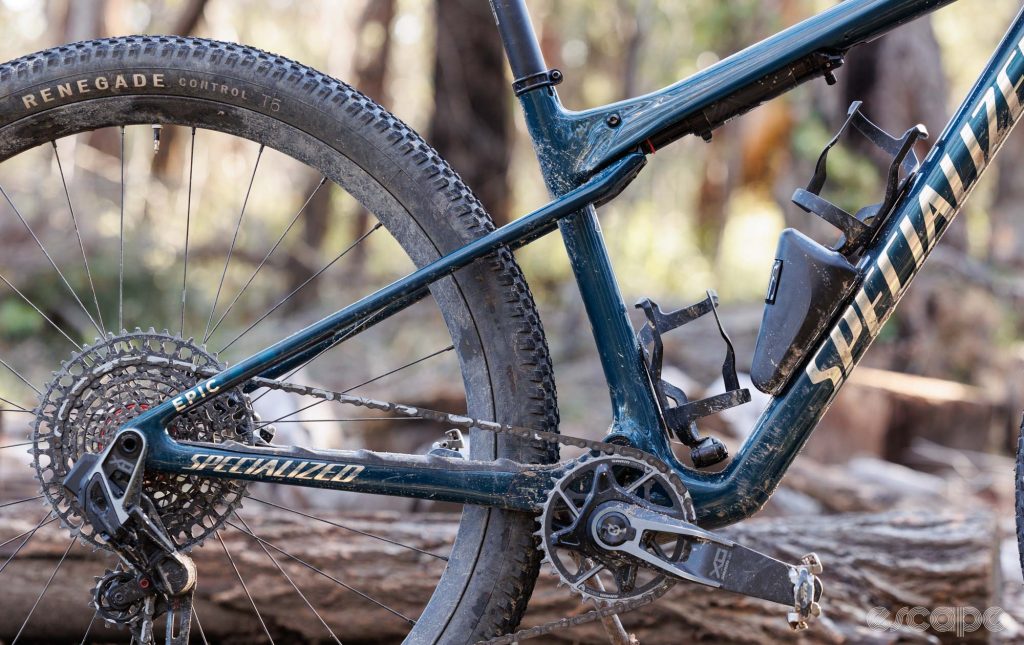
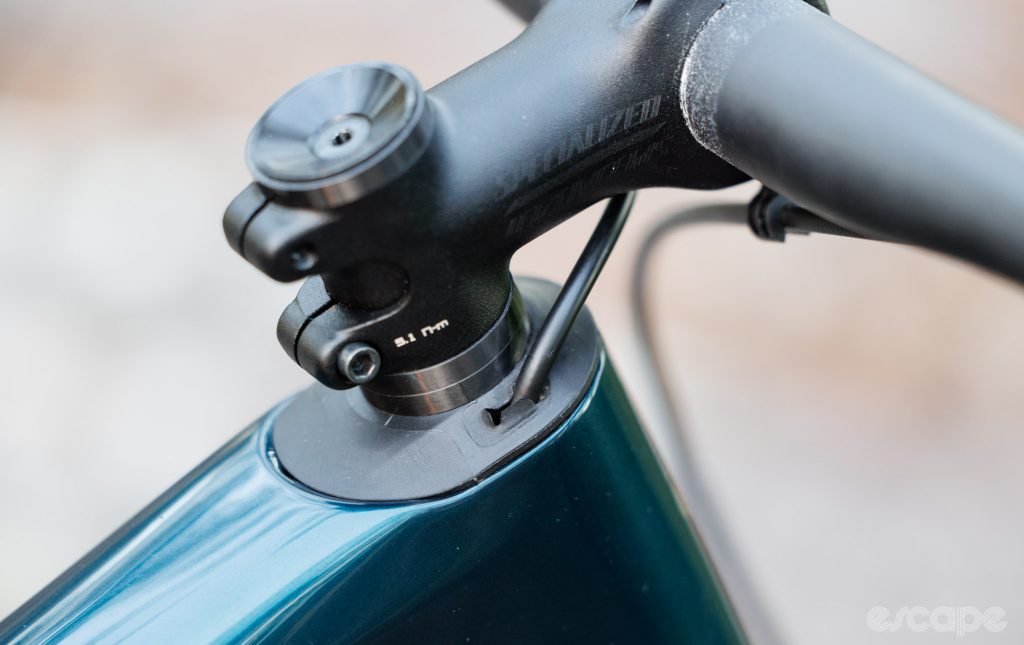
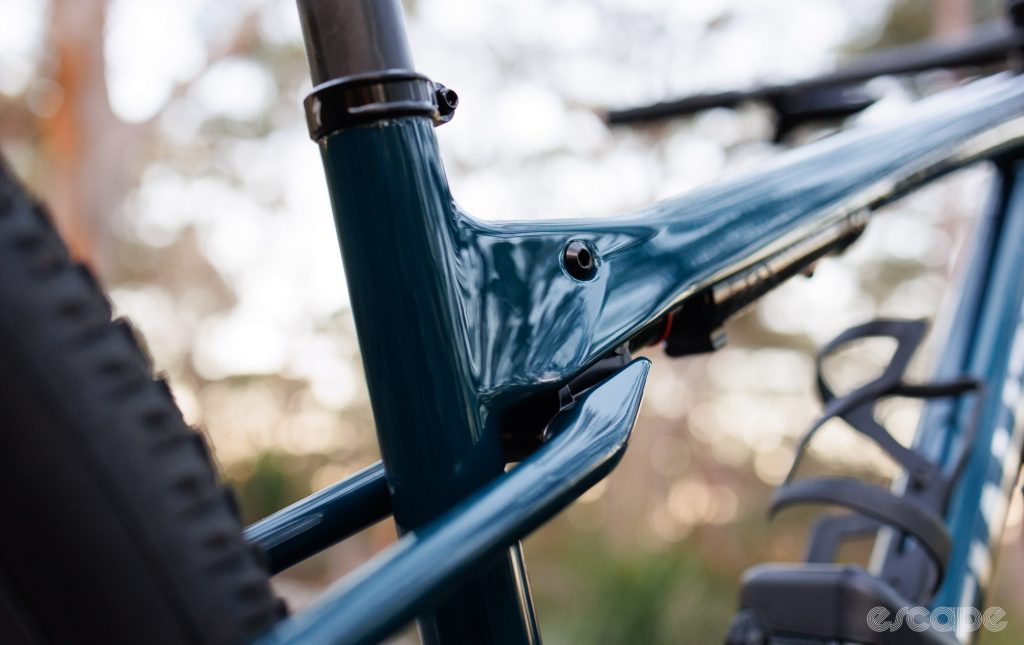
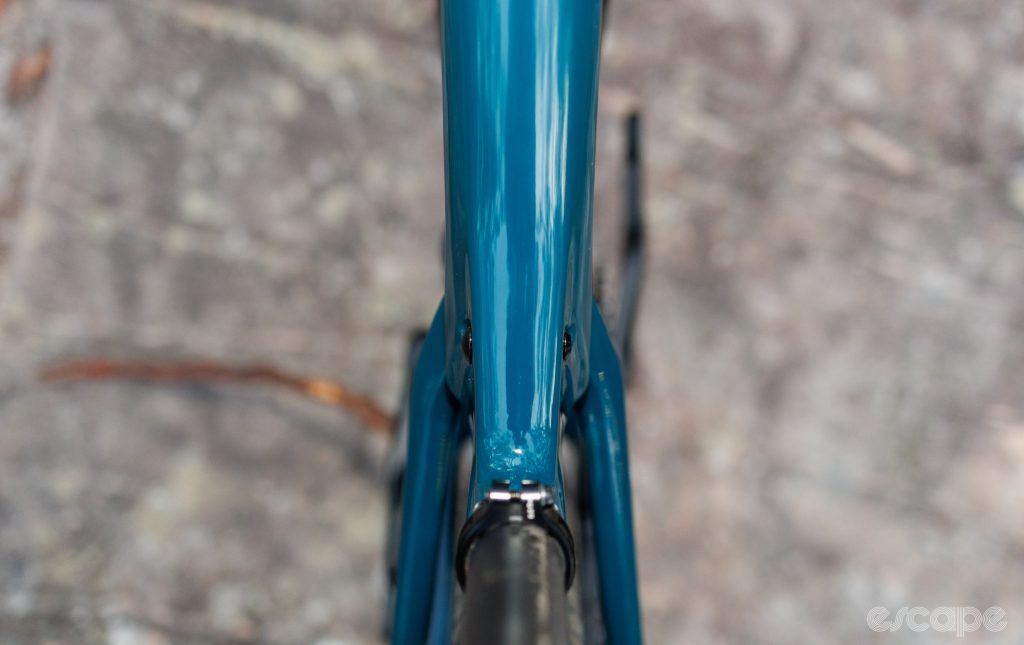
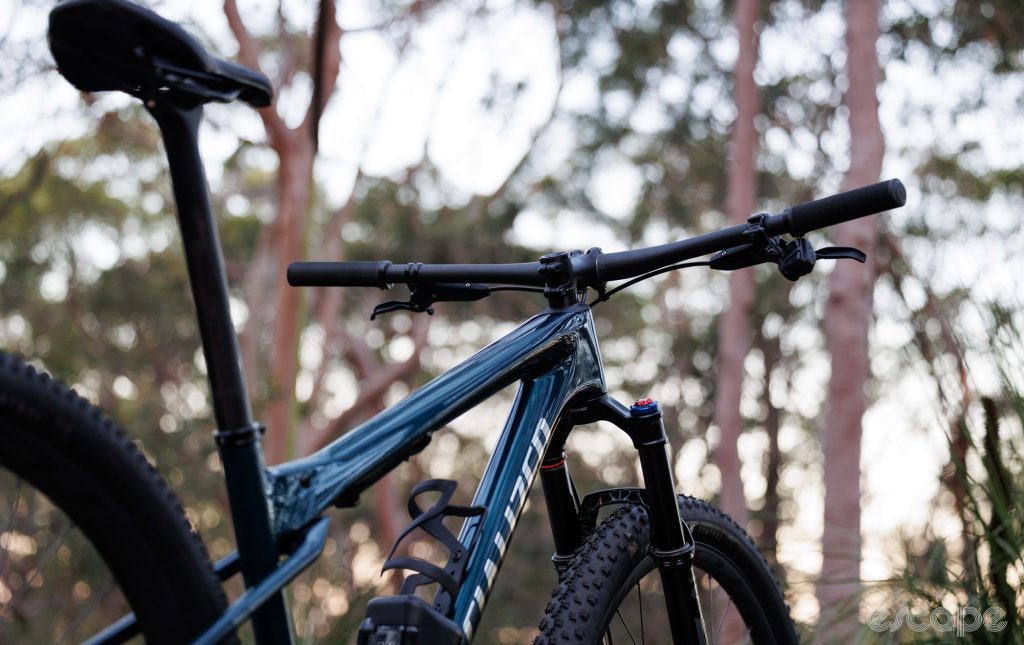
What did you think of this story?
